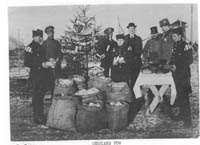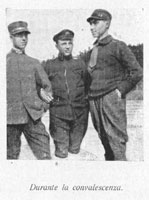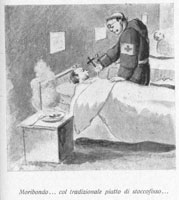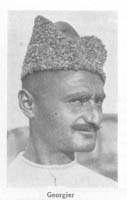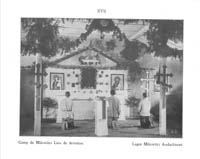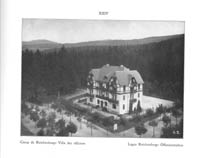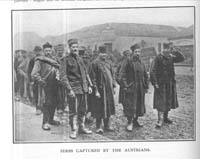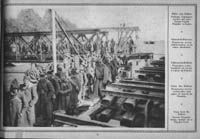Table of Contents
Chapter 9
The American YMCA and WPA Operations in Austria-Hungary
1
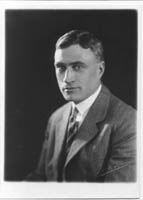 Christian Phildius remained in charge of YMCA POW operations in Austria-Hungary until the summer of 1916, when Edgar
F. MacNaughten arrived. The International Committee appointed MacNaughten to the post of Senior Secretary, and in
that capacity he supervised YMCA workers in the Dual Monarchy. He had served on the Army and Navy Department of the
International Committee and had extensive Association experience.
Christian Phildius remained in charge of YMCA POW operations in Austria-Hungary until the summer of 1916, when Edgar
F. MacNaughten arrived. The International Committee appointed MacNaughten to the post of Senior Secretary, and in
that capacity he supervised YMCA workers in the Dual Monarchy. He had served on the Army and Navy Department of the
International Committee and had extensive Association experience.
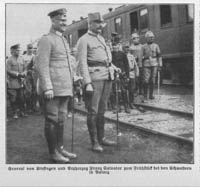 Part of the American YMCA's strategy to streamline welfare work for prisoners was to establish War Prisoners'
Aid organizations in belligerent capitals. Association secretaries worked with committees of national welfare
organizations and leading citizens to coordinate welfare programs and make POW work as efficient as possible.
The first major WPA organization was set up in Russia in November 1915, and was soon followed by similar
organizations in Germany and the Dual Monarchy. The Austro-Hungarian WPA was the most successful of these
organizations in gaining official sanction by the imperial government. Under the patronage of Franz Salvator,
Archduke of Austria-Tuscany, who served as honorary president, the WPA in the Habsburg Empire grew in importance.
Part of the American YMCA's strategy to streamline welfare work for prisoners was to establish War Prisoners'
Aid organizations in belligerent capitals. Association secretaries worked with committees of national welfare
organizations and leading citizens to coordinate welfare programs and make POW work as efficient as possible.
The first major WPA organization was set up in Russia in November 1915, and was soon followed by similar
organizations in Germany and the Dual Monarchy. The Austro-Hungarian WPA was the most successful of these
organizations in gaining official sanction by the imperial government. Under the patronage of Franz Salvator,
Archduke of Austria-Tuscany, who served as honorary president, the WPA in the Habsburg Empire grew in importance.
2
 This agency became an integral part of the general welfare services of the Austrian and Hungarian Red Cross
Societies in the spring of 1916. Baron Markus von Spiegelfeld, President of the WPA Committee of the Austrian Red Cross,
quickly embraced the goals of the American YMCA. He used his influence to expand the YMCA's POW activities in
Russia and to the Ottoman Empire. MacNaughten was appointed a member of both Red Cross committees, which gave the
American YMCA official status in the Dual Monarchy. As a result, the secretaries' privileges in the empire were
very liberal, and government officials rarely interfered with their activities. For example, American YMCA secretaries
received permission to reside inside Austro-Hungarian prison camps and were allowed unrestricted right of entry,
whereas Association secretaries in other countries were normally limited to only a few hours of visitation per
day.1
This agency became an integral part of the general welfare services of the Austrian and Hungarian Red Cross
Societies in the spring of 1916. Baron Markus von Spiegelfeld, President of the WPA Committee of the Austrian Red Cross,
quickly embraced the goals of the American YMCA. He used his influence to expand the YMCA's POW activities in
Russia and to the Ottoman Empire. MacNaughten was appointed a member of both Red Cross committees, which gave the
American YMCA official status in the Dual Monarchy. As a result, the secretaries' privileges in the empire were
very liberal, and government officials rarely interfered with their activities. For example, American YMCA secretaries
received permission to reside inside Austro-Hungarian prison camps and were allowed unrestricted right of entry,
whereas Association secretaries in other countries were normally limited to only a few hours of visitation per
day.1
3
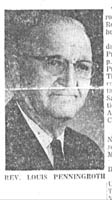 The American YMCA set up Association POW programs in thirty-four prison camps in Austria-Hungary between December
1915 and October 1917 (out of a total of fifty war prisons in the Dual Monarchy). The American Association established
POW programs in all of the empire's twenty-eight major prison camps, which included a YMCA hut or barrack and assigned
personnel. Fifteen secretaries (all but one Americans) conducted the operations in these prison camps during this time.
The International Committee assigned Dr. Julius F. Hecker to assist MacNaughten and supervise the work for Russian
POWs. He was born in Petrograd of German-French heritage, and received his education in Russian schools. He kept
his German citizenship until he traveled to the United States when he was twenty-one and applied for naturalization.
After receiving his doctorate from Columbia University, Hecker directed the Methodist Church Mission for Russians
in New York City. His command of Russian, English, and German permitted him to work equally well with Austro-Hungarian
officials, POWs, and his fellow American secretaries. The Kriegsgefangenenhilfe (War Prisoners' Aid) headquarters were established
in Vienna in March 1916 with Jean Schoop, a Swiss secretary, as the initial staff member. Schoop was a German Swiss
national with considerable Association experience. From 1902 to 1914, Schoop had been the General Secretary of the
German YMCA in Petrograd, and he spoke fluent German, English, and Russian, making him ideal for work in Austria-Hungary.
The Vienna office served as the Central Bureau for YMCA POW operations in the Dual Monarchy. Louis P. Penningroth arrived
from the United States in March 1916; after initially conducting field work at Braunau-in-Böhmen, MacNaughten
reassigned Penningroth to Vienna to coordinate WPA operations from July 1916 to March 1917, when he was scheduled to
be transfer to Sofia to become the Senior Secretary for American YMCA POW operations in Bulgaria. Penningroth was
assisted in Vienna by Lars Stubbe Teglbjärg, a Danish secretary assigned to the American YMCA POW service, from
November 1916 to September 1918. MacNaughten served the as Senior Secretary and oversaw all YMCA operations until his
departure shortly before the U.S. declared war on Austria-Hungary.2
The American YMCA set up Association POW programs in thirty-four prison camps in Austria-Hungary between December
1915 and October 1917 (out of a total of fifty war prisons in the Dual Monarchy). The American Association established
POW programs in all of the empire's twenty-eight major prison camps, which included a YMCA hut or barrack and assigned
personnel. Fifteen secretaries (all but one Americans) conducted the operations in these prison camps during this time.
The International Committee assigned Dr. Julius F. Hecker to assist MacNaughten and supervise the work for Russian
POWs. He was born in Petrograd of German-French heritage, and received his education in Russian schools. He kept
his German citizenship until he traveled to the United States when he was twenty-one and applied for naturalization.
After receiving his doctorate from Columbia University, Hecker directed the Methodist Church Mission for Russians
in New York City. His command of Russian, English, and German permitted him to work equally well with Austro-Hungarian
officials, POWs, and his fellow American secretaries. The Kriegsgefangenenhilfe (War Prisoners' Aid) headquarters were established
in Vienna in March 1916 with Jean Schoop, a Swiss secretary, as the initial staff member. Schoop was a German Swiss
national with considerable Association experience. From 1902 to 1914, Schoop had been the General Secretary of the
German YMCA in Petrograd, and he spoke fluent German, English, and Russian, making him ideal for work in Austria-Hungary.
The Vienna office served as the Central Bureau for YMCA POW operations in the Dual Monarchy. Louis P. Penningroth arrived
from the United States in March 1916; after initially conducting field work at Braunau-in-Böhmen, MacNaughten
reassigned Penningroth to Vienna to coordinate WPA operations from July 1916 to March 1917, when he was scheduled to
be transfer to Sofia to become the Senior Secretary for American YMCA POW operations in Bulgaria. Penningroth was
assisted in Vienna by Lars Stubbe Teglbjärg, a Danish secretary assigned to the American YMCA POW service, from
November 1916 to September 1918. MacNaughten served the as Senior Secretary and oversaw all YMCA operations until his
departure shortly before the U.S. declared war on Austria-Hungary.2
4
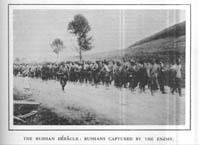 The Central Bureau in Vienna worked to maintain daily operations in the prison camps by providing supplies,
communications, and personnel as efficiently as possible. Most of the Russian, Serbian, Romanian, and Italian
prisoners were poor and lacked education. Their families did not have the resources to send packages to improve
their condition, nor could their governments extend much help. As the war dragged on and the Allied blockade of
the Central Powers became more effective, living standards for Austro-Hungarian prisoners fell drastically. By
1917, prison rations were limited to cabbage or beef soup, one-quarter loaf of black bread per day, and an
occasional small portion of meat for each prisoner. In addition, many POWs were insufficiently clad, especially
if they were captured during summer campaigning, and coal became unobtainable. The American YMCA was not set up
to conduct physical relief operations, but conditions became so bad that secretaries made every effort to assist
welfare agencies and supplement relief supplies. Because of the extensive network the American YMCA had established
in the Austro-Hungarian war prison system, the WPA became the distributing agent and cooperated with the majority
of welfare organizations such as the Russian Red Cross, the Russian Relief Fund, and Swedish relief organizations.
Austro-Hungarian regulations on purchasing food were very strict. Even local markets offered limited supplies. The
imperial government refused to forward food parcels to POWs unless they were addressed to individuals. To improve
food deliveries, the WPA devised a system to work within these regulations. American YMCA secretaries in Denmark
and Switzerland purchased food and shipped the packets to designated prisoners in Austria-Hungary. These POWs
then handed over the packages to representatives of the cooperative societies or welfare committees in each camp.
The food was then sold at cost or distributed to the most needy. The proceeds from these sales were returned to
the YMCA, and this money was used to purchase more food parcels for POWs. The cooperative societies were extremely
useful, not only in improving prison camp living standards, but in providing a meaningful outlet for a large number
of POWs with time on their hands.3
The Central Bureau in Vienna worked to maintain daily operations in the prison camps by providing supplies,
communications, and personnel as efficiently as possible. Most of the Russian, Serbian, Romanian, and Italian
prisoners were poor and lacked education. Their families did not have the resources to send packages to improve
their condition, nor could their governments extend much help. As the war dragged on and the Allied blockade of
the Central Powers became more effective, living standards for Austro-Hungarian prisoners fell drastically. By
1917, prison rations were limited to cabbage or beef soup, one-quarter loaf of black bread per day, and an
occasional small portion of meat for each prisoner. In addition, many POWs were insufficiently clad, especially
if they were captured during summer campaigning, and coal became unobtainable. The American YMCA was not set up
to conduct physical relief operations, but conditions became so bad that secretaries made every effort to assist
welfare agencies and supplement relief supplies. Because of the extensive network the American YMCA had established
in the Austro-Hungarian war prison system, the WPA became the distributing agent and cooperated with the majority
of welfare organizations such as the Russian Red Cross, the Russian Relief Fund, and Swedish relief organizations.
Austro-Hungarian regulations on purchasing food were very strict. Even local markets offered limited supplies. The
imperial government refused to forward food parcels to POWs unless they were addressed to individuals. To improve
food deliveries, the WPA devised a system to work within these regulations. American YMCA secretaries in Denmark
and Switzerland purchased food and shipped the packets to designated prisoners in Austria-Hungary. These POWs
then handed over the packages to representatives of the cooperative societies or welfare committees in each camp.
The food was then sold at cost or distributed to the most needy. The proceeds from these sales were returned to
the YMCA, and this money was used to purchase more food parcels for POWs. The cooperative societies were extremely
useful, not only in improving prison camp living standards, but in providing a meaningful outlet for a large number
of POWs with time on their hands.3
5
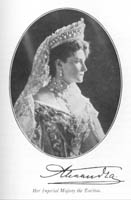 The American YMCA worked with other international relief agencies in providing services for Allied prisoners in
the Dual Monarchy. The Crown Princess of Sweden collected and shipped large quantities of food and clothing through
the American YMCA. Tsarina Alexandra Feodorovna led the Russian Relief Fund, which collected food, clothing, and
money for Russian prisoners incarcerated in Austro-Hungarian prisons. This fund sent Liebesgaben (charity
gifts), which included items from food and clothing to religious icons. These gifts carried the imperial seal and
demonstrated the Russian imperial family's concern for prisoners. These parcels were sent through the YMCA distribution
center in Copenhagen to Austria-Hungary.
The American YMCA worked with other international relief agencies in providing services for Allied prisoners in
the Dual Monarchy. The Crown Princess of Sweden collected and shipped large quantities of food and clothing through
the American YMCA. Tsarina Alexandra Feodorovna led the Russian Relief Fund, which collected food, clothing, and
money for Russian prisoners incarcerated in Austro-Hungarian prisons. This fund sent Liebesgaben (charity
gifts), which included items from food and clothing to religious icons. These gifts carried the imperial seal and
demonstrated the Russian imperial family's concern for prisoners. These parcels were sent through the YMCA distribution
center in Copenhagen to Austria-Hungary.
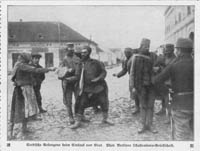 The Russian and Danish Red Crosses also conducted numerous inspection trips of prison camps in the Dual Monarchy.
The Red Cross representatives distributed funds through American YMCA secretaries. While the plight of Russian,
Italian, and Romanian POWs was great, the Serbian prisoners suffered the most. Because their country ceased to exist
after October 1915, the Serbs lost access to support from their families and their government. Association secretaries
made impassioned pleas for American citizens to donate generously to help Serbian POWs, and the International
Committee placed $20,000 in credit in Copenhagen to aid the Serbs. As YMCA workers pointed out, these POWs had no one
else to turn to, and the interned prisoners would never forget the goodwill offered by American contributors.4
The Russian and Danish Red Crosses also conducted numerous inspection trips of prison camps in the Dual Monarchy.
The Red Cross representatives distributed funds through American YMCA secretaries. While the plight of Russian,
Italian, and Romanian POWs was great, the Serbian prisoners suffered the most. Because their country ceased to exist
after October 1915, the Serbs lost access to support from their families and their government. Association secretaries
made impassioned pleas for American citizens to donate generously to help Serbian POWs, and the International
Committee placed $20,000 in credit in Copenhagen to aid the Serbs. As YMCA workers pointed out, these POWs had no one
else to turn to, and the interned prisoners would never forget the goodwill offered by American contributors.4
6
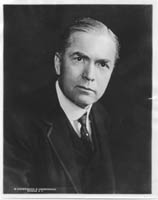 Despite these works, the combined relief efforts of the Allied governments fell far short of meeting the desperate
needs in the Dual Monarchy. The total amount of supplies available for POW relief was minuscule in comparison to
the number of war prisoners. By 1917, the Allied blockade had created famine in Central Europe, which directly
affected living standards in Dual Monarchy prison camps. The food situation became so critical that by January
1917, the Rockefeller Foundation, the International Red Cross, and the International Committee of the American
YMCA (represented by Archibald C. Harte and chaired by John R. Mott) formed the Council of Prisoners of War, with
the full approval of the State Department. The objective of this agency was to provide Allied POWs with food,
clothing, and medical supplies to supplement their daily rations to survive their imprisonment. Payment for the
supplies and the costs of transportation would be borne by the Allied government sending assistance to their
captive nationals, while the Rockefeller Foundation paid the administrative costs for the program. In addition,
funds normally dispensed by U.S. embassy officials on behalf of belligerent governments would now be distributed
by the American YMCA. Planning had proceeded to the point where the Central Powers had accepted all of the British
conditions to begin the service, and shipping and distribution networks through neutral ports had been finalized.
The relief plan collapsed, however, when the Allies decided to continue to enforce a strict blockade to force the
Central Powers to surrender, even though it meant starvation for the millions of Allied POWs in Central Europe as
well.5
Despite these works, the combined relief efforts of the Allied governments fell far short of meeting the desperate
needs in the Dual Monarchy. The total amount of supplies available for POW relief was minuscule in comparison to
the number of war prisoners. By 1917, the Allied blockade had created famine in Central Europe, which directly
affected living standards in Dual Monarchy prison camps. The food situation became so critical that by January
1917, the Rockefeller Foundation, the International Red Cross, and the International Committee of the American
YMCA (represented by Archibald C. Harte and chaired by John R. Mott) formed the Council of Prisoners of War, with
the full approval of the State Department. The objective of this agency was to provide Allied POWs with food,
clothing, and medical supplies to supplement their daily rations to survive their imprisonment. Payment for the
supplies and the costs of transportation would be borne by the Allied government sending assistance to their
captive nationals, while the Rockefeller Foundation paid the administrative costs for the program. In addition,
funds normally dispensed by U.S. embassy officials on behalf of belligerent governments would now be distributed
by the American YMCA. Planning had proceeded to the point where the Central Powers had accepted all of the British
conditions to begin the service, and shipping and distribution networks through neutral ports had been finalized.
The relief plan collapsed, however, when the Allies decided to continue to enforce a strict blockade to force the
Central Powers to surrender, even though it meant starvation for the millions of Allied POWs in Central Europe as
well.5
7
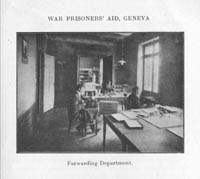 The Central Bureau also became a clearinghouse for information about war prisoners in the Dual Monarchy that the
organization shared with other WPAs in other countries. In Austria-Hungary, the Central Bureau worked with the
Austro-Hungarian Red Cross and the Austrian and Hungarian national YMCA movements to help families contact loved
ones in captivity. By exchanging data with WPA organizations in other countries, the American YMCA was able to
provide a variety of services.
The Central Bureau also became a clearinghouse for information about war prisoners in the Dual Monarchy that the
organization shared with other WPAs in other countries. In Austria-Hungary, the Central Bureau worked with the
Austro-Hungarian Red Cross and the Austrian and Hungarian national YMCA movements to help families contact loved
ones in captivity. By exchanging data with WPA organizations in other countries, the American YMCA was able to
provide a variety of services.
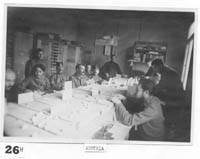 The Association tracked down lost family members who were reported missing or lost and provided prisoners with
news from home; it also transferred money to prisoners in Allied camps to help improve their living standards.
This POW information bureau became very important for families in Austria-Hungary with relatives in Russian prison
camps, easing family suffering by providing them with information about the health and location of their relatives.
For the prisoners, contact with home helped reduce their homesickness and improved their outlook on life. The Vienna
office worked with several POW organizations, such as the Association of the Families of Krasnoyarsk War Prisoners,
to help incarcerated family members through the Association's WPA central office in Petrograd.6
The Association tracked down lost family members who were reported missing or lost and provided prisoners with
news from home; it also transferred money to prisoners in Allied camps to help improve their living standards.
This POW information bureau became very important for families in Austria-Hungary with relatives in Russian prison
camps, easing family suffering by providing them with information about the health and location of their relatives.
For the prisoners, contact with home helped reduce their homesickness and improved their outlook on life. The Vienna
office worked with several POW organizations, such as the Association of the Families of Krasnoyarsk War Prisoners,
to help incarcerated family members through the Association's WPA central office in Petrograd.6
8
 With the establishment of official American YMCA relations with the Habsburg government, the International
Committee in New York sent secretaries to Austria-Hungary to provide the personnel to conduct the POW program.
After the initial Ministry of War agreement to begin operations in two prison camps, reciprocal diplomacy required
the introduction of additional secretaries for the Russian, Serbian, Italian, and Romanian POWs. Because Dual
Monarchy resources were already stretched thinly by wartime mobilization and the continuing influx of Allied
prisoners, Austro-Hungarian authorities soon recognized the value of an American social welfare organization
providing relief for POWs. By December 1915, the Ministry of War extended American YMCA access to six additional
prison camps and agreed to admit four additional neutral secretaries on the basis of reciprocity. By February
1916, the Ministry of War had permitted the establishment of five more YMCA huts, for a total of thirteen, and
agreed to admit nine new neutral secretaries, for a total of thirteen field secretaries. As a result, the
International Committee had to scramble to find qualified volunteers to work in the POW field. To be qualified,
a volunteer needed a background in the Association program and leadership experience, plus knowledge of German
or Hungarian (to communicate with prison officials) and Russian, Serbian, Italian, or Romanian (to work with the
prisoners). The language requirement severely restricted the pool of available secretaries.7
With the establishment of official American YMCA relations with the Habsburg government, the International
Committee in New York sent secretaries to Austria-Hungary to provide the personnel to conduct the POW program.
After the initial Ministry of War agreement to begin operations in two prison camps, reciprocal diplomacy required
the introduction of additional secretaries for the Russian, Serbian, Italian, and Romanian POWs. Because Dual
Monarchy resources were already stretched thinly by wartime mobilization and the continuing influx of Allied
prisoners, Austro-Hungarian authorities soon recognized the value of an American social welfare organization
providing relief for POWs. By December 1915, the Ministry of War extended American YMCA access to six additional
prison camps and agreed to admit four additional neutral secretaries on the basis of reciprocity. By February
1916, the Ministry of War had permitted the establishment of five more YMCA huts, for a total of thirteen, and
agreed to admit nine new neutral secretaries, for a total of thirteen field secretaries. As a result, the
International Committee had to scramble to find qualified volunteers to work in the POW field. To be qualified,
a volunteer needed a background in the Association program and leadership experience, plus knowledge of German
or Hungarian (to communicate with prison officials) and Russian, Serbian, Italian, or Romanian (to work with the
prisoners). The language requirement severely restricted the pool of available secretaries.7
9
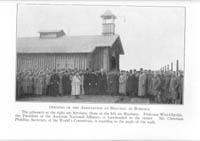 Braunau-in-Böhmen in Bohemia was the first camp the Austro-Hungarian authorities opened to YMCA workers
and the site of the first Association hut in a prison camp in the Dual Monarchy. This prison housed mostly Russian
POWs, although many Serbs were also incarcerated in Braunau. The Ministry of War granted permission to begin
operations on 11 June 1915, but the development of the WPA program was slow. Due to the lack of skilled workers
among the prisoners, construction of the Association hall was delayed. On 19 December 1915, Professor Karl Wilz-Oberlin,
president of the Austrian National YMCA Alliance, finally dedicated the opening of the Stokes Pavilion (named after James Stokes, the American benefactor who paid for the facility's construction) with Phildius and other
important dignitaries in attendance. Although the building was finished, the first secretary to undertake regular
welfare work, Penningroth, did not start until March 1916. Penningroth conducted operations for four months until
he was reassigned to the WPA Office in Vienna; he was replaced by Clarence W. Bartz who administered Red Triangle
programs from October 1916 until April 1917. The American YMCA developed an extensive program for the inmates.
Penningroth emphasized the musical program. They purchased musical instruments and obtained supplies for prisoners
to construct instruments so that the inmates could form an orchestra and a band. Bartz expanded the program after
he obtained a gramophone; he introduced concerts for the invalid prisoners recovering in the prison hospital. Through
this work, they improved morale and provided entertainment.8
Braunau-in-Böhmen in Bohemia was the first camp the Austro-Hungarian authorities opened to YMCA workers
and the site of the first Association hut in a prison camp in the Dual Monarchy. This prison housed mostly Russian
POWs, although many Serbs were also incarcerated in Braunau. The Ministry of War granted permission to begin
operations on 11 June 1915, but the development of the WPA program was slow. Due to the lack of skilled workers
among the prisoners, construction of the Association hall was delayed. On 19 December 1915, Professor Karl Wilz-Oberlin,
president of the Austrian National YMCA Alliance, finally dedicated the opening of the Stokes Pavilion (named after James Stokes, the American benefactor who paid for the facility's construction) with Phildius and other
important dignitaries in attendance. Although the building was finished, the first secretary to undertake regular
welfare work, Penningroth, did not start until March 1916. Penningroth conducted operations for four months until
he was reassigned to the WPA Office in Vienna; he was replaced by Clarence W. Bartz who administered Red Triangle
programs from October 1916 until April 1917. The American YMCA developed an extensive program for the inmates.
Penningroth emphasized the musical program. They purchased musical instruments and obtained supplies for prisoners
to construct instruments so that the inmates could form an orchestra and a band. Bartz expanded the program after
he obtained a gramophone; he introduced concerts for the invalid prisoners recovering in the prison hospital. Through
this work, they improved morale and provided entertainment.8
10
 The American secretaries also emphasized other aspects of the Association program. Penningroth set up an invalid
school where maimed POWs learned to use their new artificial limbs. More importantly, the school taught them a
new trade so they could support themselves after they returned home. The Americans established a school in the
hospital, offering elementary lessons in reading and writing. They also distributed food, books, and pictures to
lift spirits and encourage the wounded to think about the future. The secretaries acquired books to stock the
library in the Stokes Pavilion, and organized a dramatic club and theater group.
The American secretaries also emphasized other aspects of the Association program. Penningroth set up an invalid
school where maimed POWs learned to use their new artificial limbs. More importantly, the school taught them a
new trade so they could support themselves after they returned home. The Americans established a school in the
hospital, offering elementary lessons in reading and writing. They also distributed food, books, and pictures to
lift spirits and encourage the wounded to think about the future. The secretaries acquired books to stock the
library in the Stokes Pavilion, and organized a dramatic club and theater group.
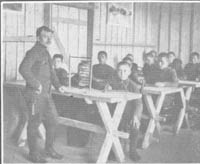 The establishment of a gymnasium helped improve the physical condition of the POWs. The hut also served a religious
role, as the Austro-Hungarian Feldkurat (military chaplain department) provided services on Sundays and
holidays. The secretaries also organized welfare committees among the POWs, which provided an important
infrastructure for supporting the Association program. The prisoners supervised the distribution of food
parcels and other materials, maintained the school and equipment, and alerted the secretaries to POWs suffering
from morale problems, especially homesickness.9
The establishment of a gymnasium helped improve the physical condition of the POWs. The hut also served a religious
role, as the Austro-Hungarian Feldkurat (military chaplain department) provided services on Sundays and
holidays. The secretaries also organized welfare committees among the POWs, which provided an important
infrastructure for supporting the Association program. The prisoners supervised the distribution of food
parcels and other materials, maintained the school and equipment, and alerted the secretaries to POWs suffering
from morale problems, especially homesickness.9
11
 The most important work provided by the American YMCA at Braunau-in-Böhmen was its program for the boys
interned in the camp. As discussed earlier, many Russian and Serbian sons followed their fathers into the army
when they were mobilized in 1914. American secretaries found 1,500 boys between the ages of eight and seventeen
at Braunau dispersed among the general prison population, without special facilities provided for their well-being
and education. Penningroth initially provided a large room in the Stokes Pavilion for their education, and the
Feldkurat agreed to begin religious instruction for the boys. The Association hut could not, however, accommodate
all of the boys. Penningroth made a proposal that included a diagram to John R. Mott for the American YMCA to
establish a Boys' Home in Braunau (he estimated the cost would be as little as six cents per boy per day). The
Austro-Hungarian Ministry of War supported the proposal, and the International Committee approved the construction
of a ten-room schoolhouse.10
The most important work provided by the American YMCA at Braunau-in-Böhmen was its program for the boys
interned in the camp. As discussed earlier, many Russian and Serbian sons followed their fathers into the army
when they were mobilized in 1914. American secretaries found 1,500 boys between the ages of eight and seventeen
at Braunau dispersed among the general prison population, without special facilities provided for their well-being
and education. Penningroth initially provided a large room in the Stokes Pavilion for their education, and the
Feldkurat agreed to begin religious instruction for the boys. The Association hut could not, however, accommodate
all of the boys. Penningroth made a proposal that included a diagram to John R. Mott for the American YMCA to
establish a Boys' Home in Braunau (he estimated the cost would be as little as six cents per boy per day). The
Austro-Hungarian Ministry of War supported the proposal, and the International Committee approved the construction
of a ten-room schoolhouse.10
12
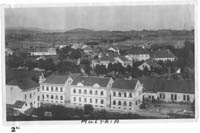 The War Ministry reserved eight barracks for dormitories, eating halls, and workshops for the boys. The camp
commandant segregated the Russian and Serbian boys from the main prison camp population and Bartz introduced an
extensive educational program. They attended other Association functions, such as theater performances, concerts,
and movies. Most importantly, secretaries sought to train these boys for the future. The boys learned a trade,
such as shoe-making, sewing, or carpentry. The Ministry of War set aside two acres of land for agricultural
instruction. Each boy had a plot of land to raise a garden and rabbits, under the supervision of an agricultural
expert. This program also expanded the prison's dwindling food supplies. Penningroth also set up an invalid school
for boys who had been maimed. This work was so successful that the American YMCA introduced similar services for
boys in Wieselburg and Nezsider in 1917. By relieving these boys of the boredom of prison life, educating them,
and teaching them a trade, the American YMCA hoped to make them more prosperous subjects and establish the foundations
of good-will for Association expansion into their countries after the war.11
The War Ministry reserved eight barracks for dormitories, eating halls, and workshops for the boys. The camp
commandant segregated the Russian and Serbian boys from the main prison camp population and Bartz introduced an
extensive educational program. They attended other Association functions, such as theater performances, concerts,
and movies. Most importantly, secretaries sought to train these boys for the future. The boys learned a trade,
such as shoe-making, sewing, or carpentry. The Ministry of War set aside two acres of land for agricultural
instruction. Each boy had a plot of land to raise a garden and rabbits, under the supervision of an agricultural
expert. This program also expanded the prison's dwindling food supplies. Penningroth also set up an invalid school
for boys who had been maimed. This work was so successful that the American YMCA introduced similar services for
boys in Wieselburg and Nezsider in 1917. By relieving these boys of the boredom of prison life, educating them,
and teaching them a trade, the American YMCA hoped to make them more prosperous subjects and establish the foundations
of good-will for Association expansion into their countries after the war.11
13
 The Austro-Hungarian Ministry of War gave permission for the YMCA to begin POW operations in Sopronnyek in Hungary
on 5 August 1915. Like Braunau-in-Böhmen, this camp had a predominantly Russian prison population. The American
YMCA provided funding for the construction of an Association hut, which was delayed due to the scarcity of skilled
prisoner labor. The official building inauguration was celebrated with great fanfare in December 1915. Jean Schoop
supervised POW operations after he arrived in July 1916, and remained attached to the camp until the end of the
war.12
The Austro-Hungarian Ministry of War gave permission for the YMCA to begin POW operations in Sopronnyek in Hungary
on 5 August 1915. Like Braunau-in-Böhmen, this camp had a predominantly Russian prison population. The American
YMCA provided funding for the construction of an Association hut, which was delayed due to the scarcity of skilled
prisoner labor. The official building inauguration was celebrated with great fanfare in December 1915. Jean Schoop
supervised POW operations after he arrived in July 1916, and remained attached to the camp until the end of the
war.12
14
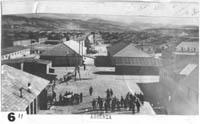 During 1915, the Ministry of War also approved the introduction of Association services at Prague and at
Brunn-am-Gebirge, Spratzern, and Wieselburg in Lower Austria. The government extended permission to enter Prague
and Brunn on May 8, and to begin work in the other two camps on December 14. Theodore F. Schroeder was one of the
first two American secretaries to arrive in Austria-Hungary, and he began work in Spratzern in March 1916. He
brought a soccer ball as part of his equipment, and found it very useful in helping wounded POWs recover as a
means of physical therapy.
During 1915, the Ministry of War also approved the introduction of Association services at Prague and at
Brunn-am-Gebirge, Spratzern, and Wieselburg in Lower Austria. The government extended permission to enter Prague
and Brunn on May 8, and to begin work in the other two camps on December 14. Theodore F. Schroeder was one of the
first two American secretaries to arrive in Austria-Hungary, and he began work in Spratzern in March 1916. He
brought a soccer ball as part of his equipment, and found it very useful in helping wounded POWs recover as a
means of physical therapy.
 Soon crippled prisoners competed in soccer games before hundreds of convalescing POWs. Schroeder also introduced
musical entertainment for bedridden prisoners. He arranged gramophone concerts with the assistance of a Russian
prisoner, who carried the equipment. The YMCA also provided material for classes in reading, writing, and geography,
as Schroeder found that most of the prisoners were illiterate. To help the POWs find better employment after the war,
Schroeder set up woodcarving and bookbinding classes. The "Y" also sent the POWs at Spratzern playground equipment,
which included games such as Russian bowling, croquette, and horseshoes, to help prisoners pass away their idle hours.
Another American secretary, Gustav J. Kaletsch, arrived at Spratzern in February 1917 and served at the camp for two
months.13
Soon crippled prisoners competed in soccer games before hundreds of convalescing POWs. Schroeder also introduced
musical entertainment for bedridden prisoners. He arranged gramophone concerts with the assistance of a Russian
prisoner, who carried the equipment. The YMCA also provided material for classes in reading, writing, and geography,
as Schroeder found that most of the prisoners were illiterate. To help the POWs find better employment after the war,
Schroeder set up woodcarving and bookbinding classes. The "Y" also sent the POWs at Spratzern playground equipment,
which included games such as Russian bowling, croquette, and horseshoes, to help prisoners pass away their idle hours.
Another American secretary, Gustav J. Kaletsch, arrived at Spratzern in February 1917 and served at the camp for two
months.13
15
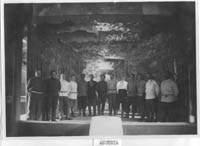 The prison camp at Wieselburg was one of the largest concentration camps in Austria, housing over seventy thousand men
in seven hundred buildings. Hecker began service at Wieselburg in March 1916, and found working in the camp rewarding.
The prison authorities welcomed the American secretary and provided the Association with several barracks and
a budget of six thousand Kronen ($800). This allowed Hecker to adapt and equip several barracks for Association
functions; he set up a church (forty meters by ten meters), which included two small rooms for prayer and
meditation.
The prison camp at Wieselburg was one of the largest concentration camps in Austria, housing over seventy thousand men
in seven hundred buildings. Hecker began service at Wieselburg in March 1916, and found working in the camp rewarding.
The prison authorities welcomed the American secretary and provided the Association with several barracks and
a budget of six thousand Kronen ($800). This allowed Hecker to adapt and equip several barracks for Association
functions; he set up a church (forty meters by ten meters), which included two small rooms for prayer and
meditation.
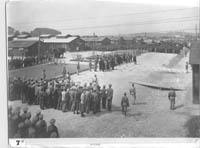 The prisoners modified a large barrack to include a theater, lecture hall, concert hall, school, and library. A
third barrack became a cinema after the arrival of a movie projector for educational and entertainment purposes.
This barrack was also used by the camp's non-Christian population with the consent of the Christian and non-Christian
POWs. With such a large infrastructure, Hecker developed an extensive Association program. The dramatic society
staged high-quality productions with the support of the camp's orchestra.
The prisoners modified a large barrack to include a theater, lecture hall, concert hall, school, and library. A
third barrack became a cinema after the arrival of a movie projector for educational and entertainment purposes.
This barrack was also used by the camp's non-Christian population with the consent of the Christian and non-Christian
POWs. With such a large infrastructure, Hecker developed an extensive Association program. The dramatic society
staged high-quality productions with the support of the camp's orchestra.
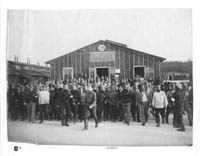 Hecker also organized two libraries-one for the guards to relieve their boredom, and the other for the prisoners.
He purchased Russian, Polish, Hebrew, and German books in Berlin and Vienna to stock the libraries, although there
was always a shortage of Russian texts. Some prisoners even donated their own private books to the general collection.
To ease the Russian book shortage, Hecker arranged for the prisoners to produce reprints. This program was especially
important, since almost 90 percent of the camp's inmate population temporarily left the prison for work assignments,
and they demanded literature for diversion away from the camp. After a book was approved by the camp censor, the
POWs could produce a thirty-two-page pamphlet at a cost of six hundred Kronen for ten thousand copies. Hecker arranged to have
these printings distributed to other prison camps in Germany and Austria-Hungary to help alleviate the book
shortage.14
Hecker also organized two libraries-one for the guards to relieve their boredom, and the other for the prisoners.
He purchased Russian, Polish, Hebrew, and German books in Berlin and Vienna to stock the libraries, although there
was always a shortage of Russian texts. Some prisoners even donated their own private books to the general collection.
To ease the Russian book shortage, Hecker arranged for the prisoners to produce reprints. This program was especially
important, since almost 90 percent of the camp's inmate population temporarily left the prison for work assignments,
and they demanded literature for diversion away from the camp. After a book was approved by the camp censor, the
POWs could produce a thirty-two-page pamphlet at a cost of six hundred Kronen for ten thousand copies. Hecker arranged to have
these printings distributed to other prison camps in Germany and Austria-Hungary to help alleviate the book
shortage.14
16
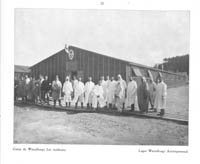 The prison camp at Wieselburg provided extensive medical services through numerous hospitals and invalid wards
for Allied prisoners. Over five thousand POWs in this camp suffered from wounds or illness, and Hecker organized a
welfare committee to render assistance. This committee listed prisoners who did not receive help from home and
could not work, and the YMCA focused their limited resources on these men. Hecker praised the Austro-Hungarian
authorities for their work in fitting amputees with artificial limbs.
The prison camp at Wieselburg provided extensive medical services through numerous hospitals and invalid wards
for Allied prisoners. Over five thousand POWs in this camp suffered from wounds or illness, and Hecker organized a
welfare committee to render assistance. This committee listed prisoners who did not receive help from home and
could not work, and the YMCA focused their limited resources on these men. Hecker praised the Austro-Hungarian
authorities for their work in fitting amputees with artificial limbs.
 They built a shop to produce limbs, and outfitted a therapeutic hospital with modern equipment for physical
therapy. Dr. Duschak, the chief physician in the trauma department, was a dedicated doctor and worked well with
Hecker. The American YMCA provided him with tonics and special drugs. Hecker also worked with Duschak to organize
invalid schools where wounded prisoners could learn new trades. Most invalids remained idle, and their condition
gradually deteriorated. They were potentially an army of paupers and idlers who would become a strain on their
home communities after the end of the war. Through American YMCA funding, wounded soldiers learned new skills
and professions and were prepared to return home ready to resume their roles as family providers.
They built a shop to produce limbs, and outfitted a therapeutic hospital with modern equipment for physical
therapy. Dr. Duschak, the chief physician in the trauma department, was a dedicated doctor and worked well with
Hecker. The American YMCA provided him with tonics and special drugs. Hecker also worked with Duschak to organize
invalid schools where wounded prisoners could learn new trades. Most invalids remained idle, and their condition
gradually deteriorated. They were potentially an army of paupers and idlers who would become a strain on their
home communities after the end of the war. Through American YMCA funding, wounded soldiers learned new skills
and professions and were prepared to return home ready to resume their roles as family providers.
17
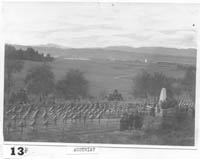 Hecker was convinced that service to invalids was the greatest moral and social service the YMCA could render.
The major obstacle was finding teachers to staff the invalid school. Hecker found sixteen educators among
the POW population, and then surveyed the condition and education levels of the wounded students. An Austro-Hungarian
officer provided barracks for the school, and the American YMCA funded the program and obtained the necessary
equipment such as benches, machines, and tools for the training program. Hecker began the program with a budget
of two thousand Kronen, and American contributors sent additional aid. As Hecker pointed out, for a few thousand
dollars the YMCA could teach thousands of invalids useful occupations and save them from physical and moral
degradation. Hecker's project was so successful that the Austro-Hungarian authorities asked him to visit an invalid
institution for wounded Austro-Hungarian soldiers in Vienna. In addition, Hecker helped organize and raise funds for
a consumptive hospital in Wieselburg. An Austrian reserve officer-a friend of the YMCA-contributed the initial three thousand Kronen, and American contributors augmented the total.15
Hecker was convinced that service to invalids was the greatest moral and social service the YMCA could render.
The major obstacle was finding teachers to staff the invalid school. Hecker found sixteen educators among
the POW population, and then surveyed the condition and education levels of the wounded students. An Austro-Hungarian
officer provided barracks for the school, and the American YMCA funded the program and obtained the necessary
equipment such as benches, machines, and tools for the training program. Hecker began the program with a budget
of two thousand Kronen, and American contributors sent additional aid. As Hecker pointed out, for a few thousand
dollars the YMCA could teach thousands of invalids useful occupations and save them from physical and moral
degradation. Hecker's project was so successful that the Austro-Hungarian authorities asked him to visit an invalid
institution for wounded Austro-Hungarian soldiers in Vienna. In addition, Hecker helped organize and raise funds for
a consumptive hospital in Wieselburg. An Austrian reserve officer-a friend of the YMCA-contributed the initial three thousand Kronen, and American contributors augmented the total.15
18
 Like Braunau-in-Böhmen, Wieselburg had a large number of boys in the general prison population. Hecker
assumed charge of the boys between twelve and seventeen. The prison authorities provided two reconstructed barracks,
while the YMCA organized a school and apprenticeship program for their training. The War Ministry decided to make
Wieselburg the primary center for young Russian POWs. Boys under the age of sixteen interned in other camps in the
Dual Monarchy were reassigned to Wieselburg. The camp commandant made Hecker the sole supervisor for the Boys'
Department, with full responsibility for their education and living arrangements. The American YMCA funded
the program and expanded the facility to include sleeping apartments, dining rooms, a gymnasium, and workshops.
Hecker also extended YMCA services to Nezsider in February 1917, including the program for boys.16
Like Braunau-in-Böhmen, Wieselburg had a large number of boys in the general prison population. Hecker
assumed charge of the boys between twelve and seventeen. The prison authorities provided two reconstructed barracks,
while the YMCA organized a school and apprenticeship program for their training. The War Ministry decided to make
Wieselburg the primary center for young Russian POWs. Boys under the age of sixteen interned in other camps in the
Dual Monarchy were reassigned to Wieselburg. The camp commandant made Hecker the sole supervisor for the Boys'
Department, with full responsibility for their education and living arrangements. The American YMCA funded
the program and expanded the facility to include sleeping apartments, dining rooms, a gymnasium, and workshops.
Hecker also extended YMCA services to Nezsider in February 1917, including the program for boys.16
19
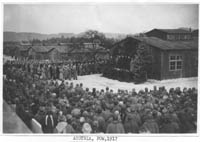 By March 1916, American secretaries had begun POW operations in three more prison camps including Hart, in
Upper Austria, as well as Purgstall and Neulengbach in Lower Austria. Hecker introduced a full YMCA program
at Purgstall, a camp full of Russian prisoners, while Schroeder began operations in Neulengbach. Schroeder
was eventually replaced by Kaletsch, who started work in the prison camp by February 1917, for a two-month
period. Through the American YMCA, the camp received instruments for a full band, and the secretary organized
a chorus.
By March 1916, American secretaries had begun POW operations in three more prison camps including Hart, in
Upper Austria, as well as Purgstall and Neulengbach in Lower Austria. Hecker introduced a full YMCA program
at Purgstall, a camp full of Russian prisoners, while Schroeder began operations in Neulengbach. Schroeder
was eventually replaced by Kaletsch, who started work in the prison camp by February 1917, for a two-month
period. Through the American YMCA, the camp received instruments for a full band, and the secretary organized
a chorus.
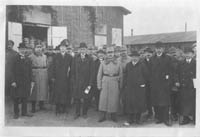 By January 1917, additional barracks were opened for YMCA activities, including a special Christmas celebration.
Hecker also established an Association POW program at Hart. In the beginning, the Austro-Hungarian camp
administration did not pay too much attention to the secretary's work. Because there had been a dearth of
educational and social work in the prison before he arrived, Hecker had immediate POW support. He obtained
and rebuilt a large barracks (thirty-five feet by one hundred-fifty feet) within the confines of the prison,
as well as a special barrack in the hospital. The American secretary found equipment for these facilities and
was able to set up the program at a cost of six thousand Kronen. With time and experience, both the camp
administrators and prisoners came to appreciate and take pride in their Association.
By January 1917, additional barracks were opened for YMCA activities, including a special Christmas celebration.
Hecker also established an Association POW program at Hart. In the beginning, the Austro-Hungarian camp
administration did not pay too much attention to the secretary's work. Because there had been a dearth of
educational and social work in the prison before he arrived, Hecker had immediate POW support. He obtained
and rebuilt a large barracks (thirty-five feet by one hundred-fifty feet) within the confines of the prison,
as well as a special barrack in the hospital. The American secretary found equipment for these facilities and
was able to set up the program at a cost of six thousand Kronen. With time and experience, both the camp
administrators and prisoners came to appreciate and take pride in their Association.
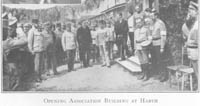 The main hut was dedicated on 15 August 1916, with visitors from the Austro-Hungarian Red Cross and staff officers
from the imperial army in attendance. The prisoners made moving speeches at the inauguration, talking about their
two years of monotony behind barbed wire. They were slowly dying of spiritual and physical attrition. They planned
revenge against their guards as well as escape plans. When life seemed darkest, the Americans arrived as "heavenly
messengers," and life in the camp changed. They forgot their sorrows and bitterness, and began building a bridge
of mutual accommodation, if not appreciation, between the prisoners and the guards. This was a moving testament
to the high value of the Association's POW work. As in Wieselburg, Hecker found a large number of boys in the
prison camp at Hart. He arranged to segregate them from the general prison population, and set up a special YMCA
school for their education.17
The main hut was dedicated on 15 August 1916, with visitors from the Austro-Hungarian Red Cross and staff officers
from the imperial army in attendance. The prisoners made moving speeches at the inauguration, talking about their
two years of monotony behind barbed wire. They were slowly dying of spiritual and physical attrition. They planned
revenge against their guards as well as escape plans. When life seemed darkest, the Americans arrived as "heavenly
messengers," and life in the camp changed. They forgot their sorrows and bitterness, and began building a bridge
of mutual accommodation, if not appreciation, between the prisoners and the guards. This was a moving testament
to the high value of the Association's POW work. As in Wieselburg, Hecker found a large number of boys in the
prison camp at Hart. He arranged to segregate them from the general prison population, and set up a special YMCA
school for their education.17
20 At Neulengbach, a prison with a predominantly Russian POW population, Schroeder found a difficult situation. The prison was divided into six separate divisions, and he had to duplicate YMCA programs for each group. The Association barrack became the center of the POW program, and the commandant made unused barracks available for Association activities. The YMCA hut was used for religious services, and Schroeder worked with the Feldkurat to distribute one thousand Gospels, crosses, and icons.
21
 The secretary also developed a school system. The first school was set up in the prison hospital, where POWs learned
to read and write Russian and German. Advanced classes included arithmetic, woodcarving, and geography. Schroeder
recruited teachers from among the Russian prisoners. The education program emphasized teaching wounded POWs who had
lost their right arms to learn to write with their left hands. The secretary also set up a school in the main prison
camp; the first students were prospective bakers, shoemakers, and tailors. To support these classes, Schroeder set
up a library system whereby Russian books that the secretary received could be distributed to each prison group
through a central library. For physical work, Schroeder had simple gymnastic equipment (parallel and horizontal
bars as well as rings) installed, and provided games including croquet and Russian bowling. He taught the POWs group
games to get them in better shape and help them spend their leisure hours more profitably. To provide some entertainment
for the inmates, Schroeder acquired some musical instruments and organized a brass band. The band played at theatrical
performances, concerts, and funeral services. Kaletsch replaced Schroeder in February and assumed supervision of POW
relief programs at Neulengbach for the next two months.18
The secretary also developed a school system. The first school was set up in the prison hospital, where POWs learned
to read and write Russian and German. Advanced classes included arithmetic, woodcarving, and geography. Schroeder
recruited teachers from among the Russian prisoners. The education program emphasized teaching wounded POWs who had
lost their right arms to learn to write with their left hands. The secretary also set up a school in the main prison
camp; the first students were prospective bakers, shoemakers, and tailors. To support these classes, Schroeder set
up a library system whereby Russian books that the secretary received could be distributed to each prison group
through a central library. For physical work, Schroeder had simple gymnastic equipment (parallel and horizontal
bars as well as rings) installed, and provided games including croquet and Russian bowling. He taught the POWs group
games to get them in better shape and help them spend their leisure hours more profitably. To provide some entertainment
for the inmates, Schroeder acquired some musical instruments and organized a brass band. The band played at theatrical
performances, concerts, and funeral services. Kaletsch replaced Schroeder in February and assumed supervision of POW
relief programs at Neulengbach for the next two months.18
22
 The YMCA introduced WPA operations at Braunau-am-Inn in Upper Austria in October 1916 when Amos A. Ebersole,
an American WPA secretary, arrived at the camp. Braunau was a large prison camp, housing almost thirty-five thousand Russian,
Italian, and Serbian prisoners of war. Tegelbjaerg assisted Ebersole in November 1916 in developing the Red
Triangle program in the facility. Ebersole believed his most important contribution to the morale of the prison
camp was the Christmas celebrations, a difficult time for men separated from their families. He served at Braunau
until April 1917 when he left the Dual Monarchy with the other American secretaries.19
The YMCA introduced WPA operations at Braunau-am-Inn in Upper Austria in October 1916 when Amos A. Ebersole,
an American WPA secretary, arrived at the camp. Braunau was a large prison camp, housing almost thirty-five thousand Russian,
Italian, and Serbian prisoners of war. Tegelbjaerg assisted Ebersole in November 1916 in developing the Red
Triangle program in the facility. Ebersole believed his most important contribution to the morale of the prison
camp was the Christmas celebrations, a difficult time for men separated from their families. He served at Braunau
until April 1917 when he left the Dual Monarchy with the other American secretaries.19
23 After negotiations with the Italians, the American YMCA quickly set up POW operations in Mauthausen in Upper Austria. The bulk of the inmates were Italian prisoners, whose totals reached twenty thousand in early 1916. The impetus behind the introduction of Association services was the spread of rumors in Italy about the terrible conditions in Austro-Hungarian prison camps. The Italian government requested that a U.S. official conduct an investigation, and Ambassador Frederic Penfield visited the camp to assess the situation. His report did not reveal any atrocities, but he recommended that the Italian and Austro-Hungarian governments come to an agreement regarding YMCA POW services in the prison camps of both countries. The American YMCA agreed to construct a hut in Mauthausen, and Eberhard Phildius, the son of Christian Phildius, arrived in May 1916 to begin POW operations. He was eventually replaced by an American secretary, Roy Alvan Welker, by January 1917, who remained until April 1917. As in other prison camps, these secretaries set up an extensive educational system with a wide variety of courses. Due to the large number of college students among the Italian prisoners, the YMCA was able to offer university extension classes at Mauthausen. During his inspection trip, Ambassador Penfield also recommended that the American YMCA construct a hut at Katzenau, where fifty thousand Italian civilians were interned. The Association agreed, and arranged with the Austro-Hungarian Ministry of War to begin operations by July 1916.20
American YMCA Operations in Hungary
24
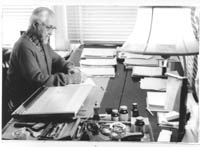 American Association work in Hungarian prison camps expanded tremendously from July to November 1916. Secretaries
began operations in seven prisons in July, one camp in September, and another by November. Raymond J. Reitzel
began work at Zalägerszeg in July 1916, a prison camp filled with Russian POWs. He found the Austro-Hungarian
officers very sympathetic and liberal, which allowed him to establish an extensive POW program. Camp officials
allowed prisoners (with special permission) to go out into the fields or factories without guards to learn a
trade. Protestant and Catholic POWs attended church services on Sundays outside of camp. Reitzel developed a
full Association POW program at Zalägerszeg.
American Association work in Hungarian prison camps expanded tremendously from July to November 1916. Secretaries
began operations in seven prisons in July, one camp in September, and another by November. Raymond J. Reitzel
began work at Zalägerszeg in July 1916, a prison camp filled with Russian POWs. He found the Austro-Hungarian
officers very sympathetic and liberal, which allowed him to establish an extensive POW program. Camp officials
allowed prisoners (with special permission) to go out into the fields or factories without guards to learn a
trade. Protestant and Catholic POWs attended church services on Sundays outside of camp. Reitzel developed a
full Association POW program at Zalägerszeg.
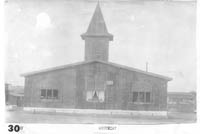 In the YMCA barrack, the secretary set up classes for both elementary and advanced students. The Commissary Group
organized an alphabet school to teach illiterate POWs simple reading and writing, plus a class for elementary
drawing. For more advanced students, classes in painting and drawing started, with the Association providing the
materials. Reitzel found three instructors, who began classes in music, languages, and science. Russian officers
in particular were very interested in furthering their educations. The secretary also set up a reading and writing
school for the officers' orderlies, which included almost one hundred men. Over time, Reitzel gradually assembled
a library, which was run by the POWs. In addition, he set up an elementary school in the prison hospital to teach
wounded and sick POWs reading, writing, and arithmetic. Reitzel was eventually able to expand the classes to more
advanced levels.21
In the YMCA barrack, the secretary set up classes for both elementary and advanced students. The Commissary Group
organized an alphabet school to teach illiterate POWs simple reading and writing, plus a class for elementary
drawing. For more advanced students, classes in painting and drawing started, with the Association providing the
materials. Reitzel found three instructors, who began classes in music, languages, and science. Russian officers
in particular were very interested in furthering their educations. The secretary also set up a reading and writing
school for the officers' orderlies, which included almost one hundred men. Over time, Reitzel gradually assembled
a library, which was run by the POWs. In addition, he set up an elementary school in the prison hospital to teach
wounded and sick POWs reading, writing, and arithmetic. Reitzel was eventually able to expand the classes to more
advanced levels.21
25
 For the physical side of the Association program, Reitzel organized soccer and other sport matches, which
drew large crowds of spectators. He also developed a religious program with the support of the Austro-Hungarian
Feldkurat, which provided a chaplain. They distributed Russian crosses and icons among the POWs and to
members of work parties. Most of the internees in this camp were Russian Orthodox. Reitzel arranged for a separate
barrack to be converted into a place of worship; the prisoners constructed a fine wooden altar with icons for
their devotional services. Reitzel developed the social side of the Association program as well. He organized
a string orchestra in the main camp that gave concerts, both to the general population and in the camp hospital.
Reitzel also formed a chorus, with music and instruments provided by the American YMCA. He even found a piano,
which he placed at the disposal of a Moscow opera singer who then taught music and assisted with the concert
program. For entertainment in the hospital, Reitzel provided a gramophone and a small portable kinescope; prison
officials placed a large hall at the secretary's disposal two times a week for performances. For inmates too sick
to move, Reitzel organized concerts and kinescope shows for their barracks. He also distributed a large number
of games throughout the wards to help the prisoners pass the time during their convalescence.22
For the physical side of the Association program, Reitzel organized soccer and other sport matches, which
drew large crowds of spectators. He also developed a religious program with the support of the Austro-Hungarian
Feldkurat, which provided a chaplain. They distributed Russian crosses and icons among the POWs and to
members of work parties. Most of the internees in this camp were Russian Orthodox. Reitzel arranged for a separate
barrack to be converted into a place of worship; the prisoners constructed a fine wooden altar with icons for
their devotional services. Reitzel developed the social side of the Association program as well. He organized
a string orchestra in the main camp that gave concerts, both to the general population and in the camp hospital.
Reitzel also formed a chorus, with music and instruments provided by the American YMCA. He even found a piano,
which he placed at the disposal of a Moscow opera singer who then taught music and assisted with the concert
program. For entertainment in the hospital, Reitzel provided a gramophone and a small portable kinescope; prison
officials placed a large hall at the secretary's disposal two times a week for performances. For inmates too sick
to move, Reitzel organized concerts and kinescope shows for their barracks. He also distributed a large number
of games throughout the wards to help the prisoners pass the time during their convalescence.22
26
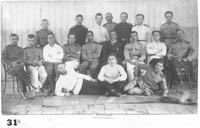 Reitzel also imported the American concept of developing self-help groups to help alleviate welfare problems
in the camp. He set up a camp "cabinet," which served as the POWs' administrative agency, and then organized
committees to address specific issues. The emphasis of this social relief program was on prisoners' aiding
their comrades through their period of confinement. Organized as the "Russian One Year's Volunteers," the POWs
adopted policies and implemented changes that improved living conditions in the camp. One committee focused on
expanding relief work in the hospitals, especially for the critically ill. They worked in conjunction with the
regimental physician to improve conditions, and Reitzel supported their work by providing supplies and equipment,
including musical instruments. Through this self-help program, prisoners avoided boredom and inactivity and
channeled their interests and energies in a positive direction. From Reitzel's perspective, this relief work
had particular rewards for the Association. Not only would Russian prisoners return home after the war with a
warm spot for the YMCA in their hearts, which would lay the basis for postwar Association expansion, but several
of these men indicated their interest in becoming YMCA secretaries after the war. By recruiting native secretaries,
the Association would gain a tremendous advantage in developing future organizations in Russia once the fighting
ended.23
Reitzel also imported the American concept of developing self-help groups to help alleviate welfare problems
in the camp. He set up a camp "cabinet," which served as the POWs' administrative agency, and then organized
committees to address specific issues. The emphasis of this social relief program was on prisoners' aiding
their comrades through their period of confinement. Organized as the "Russian One Year's Volunteers," the POWs
adopted policies and implemented changes that improved living conditions in the camp. One committee focused on
expanding relief work in the hospitals, especially for the critically ill. They worked in conjunction with the
regimental physician to improve conditions, and Reitzel supported their work by providing supplies and equipment,
including musical instruments. Through this self-help program, prisoners avoided boredom and inactivity and
channeled their interests and energies in a positive direction. From Reitzel's perspective, this relief work
had particular rewards for the Association. Not only would Russian prisoners return home after the war with a
warm spot for the YMCA in their hearts, which would lay the basis for postwar Association expansion, but several
of these men indicated their interest in becoming YMCA secretaries after the war. By recruiting native secretaries,
the Association would gain a tremendous advantage in developing future organizations in Russia once the fighting
ended.23
27
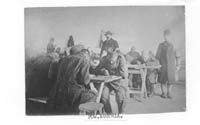 The YMCA also began operations in Somorja, Boldagasszonyfa, Dunaszerdahly, Ostffyasszonyfa, and Nagymegyer
in Hungary in July 1916. Reitzel established and maintained YMCA POW operations at Ostffiassyzonyfa and
Somorja until March 1917. World's Alliance secretaries conducted the POW programs at the other three camps.
Schoop, a Swiss secretary, started the Association program at Boldogasszonyfa after an inspection trip to
the prison in May 1916.
The YMCA also began operations in Somorja, Boldagasszonyfa, Dunaszerdahly, Ostffyasszonyfa, and Nagymegyer
in Hungary in July 1916. Reitzel established and maintained YMCA POW operations at Ostffiassyzonyfa and
Somorja until March 1917. World's Alliance secretaries conducted the POW programs at the other three camps.
Schoop, a Swiss secretary, started the Association program at Boldogasszonyfa after an inspection trip to
the prison in May 1916.
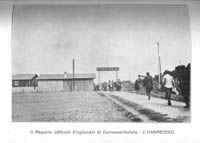 This prison was filled with Serbian POWs who were in great need of attention. Schoop set up three YMCA
elementary schools to combat the rampant illiteracy. After acquiring a barrack, the secretary modified the
building for use with a motion picture theater, lecture hall, reading rooms, and library. He was able to
obtain a small library of one hundred books in Serbian, which became the nucleus of the POW library. Schoop also
acquired games for the reading rooms.
This prison was filled with Serbian POWs who were in great need of attention. Schoop set up three YMCA
elementary schools to combat the rampant illiteracy. After acquiring a barrack, the secretary modified the
building for use with a motion picture theater, lecture hall, reading rooms, and library. He was able to
obtain a small library of one hundred books in Serbian, which became the nucleus of the POW library. Schoop also
acquired games for the reading rooms.
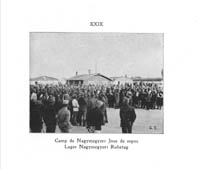 In addition, Schoop divided the lecture room in half and encouraged the guards to use one of the spaces.
A soldier's library for the guards began when an officer donated forty Hungarian books to the Association.
Schoop maintained YMCA operations in Boldagasszonyfa until the end of the war. Heinrich A. Münger, also
a Swiss secretary, supervised Association operations in Dunaszerdahly and Nagymegyer, beginning in June 1916.
The first prison camp was composed primarily of Serbian prisoners, while the latter prison was filled with
Russian POWs. A few months after his initial work at these camps, Münger instituted YMCA services at Munger,
near Nagymegyer, a prison camp for Serbian POWs. Münger continued to serve at these three POW camps for the
duration of World War I.24
In addition, Schoop divided the lecture room in half and encouraged the guards to use one of the spaces.
A soldier's library for the guards began when an officer donated forty Hungarian books to the Association.
Schoop maintained YMCA operations in Boldagasszonyfa until the end of the war. Heinrich A. Münger, also
a Swiss secretary, supervised Association operations in Dunaszerdahly and Nagymegyer, beginning in June 1916.
The first prison camp was composed primarily of Serbian prisoners, while the latter prison was filled with
Russian POWs. A few months after his initial work at these camps, Münger instituted YMCA services at Munger,
near Nagymegyer, a prison camp for Serbian POWs. Münger continued to serve at these three POW camps for the
duration of World War I.24
28
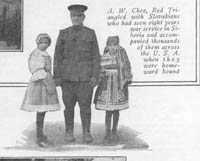 Another major prison camp in Hungary that was home to an extensive Association operation was Kenyermezö,
one of the largest in the kingdom. Anthony W. Chez started working in the prison, which had a predominantly
Russian POW population, in September 1916. One of his first projects was to open a school constructed by the
prisoners. Within a month of the school's opening, Chez reported that it was filled to capacity. He also
provided entertainment with a kinetoscope, a performance many POWs had never before seen. He took the machine
to the camp hospital where four hundred men crowded in to see shows. Due to the success of these programs, Chez was
constantly searching for additional Russian books, especially lesson texts, and a phonograph to expand his
entertainment program. Like other secretaries, Chez sought to establish good relations with the camp guards
and officials and provide them with YMCA services. He obtained a stock of Hungarian books to loan to officers
and guards. He also expanded services into the military hospitals around Kenyermezö. Chez took the
kinetoscope and gave shows for invalids and convalescents, with five hundred showing up for the first presentation.
Because of the popularity of the shows, the chief surgeon requested that the machine remain in the hospital.
Chez conducted operations in Kenyermezö until he departed in April 1917.25
Another major prison camp in Hungary that was home to an extensive Association operation was Kenyermezö,
one of the largest in the kingdom. Anthony W. Chez started working in the prison, which had a predominantly
Russian POW population, in September 1916. One of his first projects was to open a school constructed by the
prisoners. Within a month of the school's opening, Chez reported that it was filled to capacity. He also
provided entertainment with a kinetoscope, a performance many POWs had never before seen. He took the machine
to the camp hospital where four hundred men crowded in to see shows. Due to the success of these programs, Chez was
constantly searching for additional Russian books, especially lesson texts, and a phonograph to expand his
entertainment program. Like other secretaries, Chez sought to establish good relations with the camp guards
and officials and provide them with YMCA services. He obtained a stock of Hungarian books to loan to officers
and guards. He also expanded services into the military hospitals around Kenyermezö. Chez took the
kinetoscope and gave shows for invalids and convalescents, with five hundred showing up for the first presentation.
Because of the popularity of the shows, the chief surgeon requested that the machine remain in the hospital.
Chez conducted operations in Kenyermezö until he departed in April 1917.25
29
 With the arrival of additional American secretaries, the YMCA expanded their POW operations to Bohemia,
establishing programs in eight prison camps between July and October 1916. MacPherson H. Donaldson began POW
services in Eger and Heinrichsgrün in July, the first composed primarily of Russian and some Serbian
prisoners while the latter accommodated Italian POWs. He focused on educational work, especially teaching
illiterate Russians to read and write. Donaldson developed an extensive library system in his camps. The
American YMCA donated the nucleus of the Russian library, and POWs soon donated the books they had brought
with them into captivity. By early 1917, the Russian Red Cross had shipped additional stocks to the library.
Books were then distributed through the school, reserve hospital, and to work parties away from camp. For
entertainment, Donaldson obtained a gramophone, which he used for concerts, as well as musical instruments,
including mandolins, guitars, violins, balalaikas, accordions, and harmonicas. Prisoners could practice and
perform every evening, and Caucasian POWs played folk music. The secretary introduced a physical program that
included one hundred-man team soccer games and set up parallel bars and other gymnastic equipment.26
With the arrival of additional American secretaries, the YMCA expanded their POW operations to Bohemia,
establishing programs in eight prison camps between July and October 1916. MacPherson H. Donaldson began POW
services in Eger and Heinrichsgrün in July, the first composed primarily of Russian and some Serbian
prisoners while the latter accommodated Italian POWs. He focused on educational work, especially teaching
illiterate Russians to read and write. Donaldson developed an extensive library system in his camps. The
American YMCA donated the nucleus of the Russian library, and POWs soon donated the books they had brought
with them into captivity. By early 1917, the Russian Red Cross had shipped additional stocks to the library.
Books were then distributed through the school, reserve hospital, and to work parties away from camp. For
entertainment, Donaldson obtained a gramophone, which he used for concerts, as well as musical instruments,
including mandolins, guitars, violins, balalaikas, accordions, and harmonicas. Prisoners could practice and
perform every evening, and Caucasian POWs played folk music. The secretary introduced a physical program that
included one hundred-man team soccer games and set up parallel bars and other gymnastic equipment.26
30 Donaldson also arranged to have a Greek Orthodox chaplain distribute icons and Russian crosses to POWs as part of religious work for the POWs. The prison doctor recommended that Donaldson use Russian relief money to purchase eyeglasses for needy prisoners. In the reserve hospital, the secretary extended the elementary school with the assistance of Serbian and Russian teachers among the prisoners. Donaldson visited the sick and wounded prisoners and provided them with a gramophone and musical instruments (balalaikas and mandolins). Donaldson remained at these prison camps until the American secretaries departed the Dual Monarchy in April 1917.27
31 One interesting note to Donaldson's work in Eger is that he developed schools specifically for Georgian and Tartar prisoners. At the Georgian School, conducted in a mess barrack, 388 students worked on Georgian and Russian studies. The Tartar School was larger and met in several barracks. Students focused on Tartar, German, Russian, mathematics, geography, and other subjects. The American YMCA provided the primers and equipment for both schools. While the curricula did include Russian, Donaldson clearly sought to maintain and develop national aspirations as well, one of the principles espoused by Woodrow Wilson. Whether Russian authorities would have supported these schools without qualification is questionable, and the Austro-Hungarians may have been promoting these institutions for their own reasons. Both the Allies and Central Powers attempted to recruit sympathizers from among the prisoner ranks, and post-war Austro-Hungarian foreign policy would have welcomed future nationalist leaders returning to the Caucasus and Russian steppes to undermine Russian power.28
Expansion of American WPA Service in Austria
32
 Another American secretary, William E. Lauterbach, began POW work in four Bohemian prison camps beginning
in October 1916. He set up operations at the officers' prison camp at Brüx (in the vicinity of Eger) and in
the enlisted men's camps at Deutsch-Gabel, Reichenberg, and Theresienstadt. Chez took over the POW work at Brüx
for two months in February 1917, but Lauterbach continued at the other three prisons until April 1917. Clarence W.
Bartz entered the POW field in the Dual Monarchy at the same time as Lauterbach. He set up Association programs at
Another American secretary, William E. Lauterbach, began POW work in four Bohemian prison camps beginning
in October 1916. He set up operations at the officers' prison camp at Brüx (in the vicinity of Eger) and in
the enlisted men's camps at Deutsch-Gabel, Reichenberg, and Theresienstadt. Chez took over the POW work at Brüx
for two months in February 1917, but Lauterbach continued at the other three prisons until April 1917. Clarence W.
Bartz entered the POW field in the Dual Monarchy at the same time as Lauterbach. He set up Association programs at
 Josefstadt, a prison for Italian POWs, in October 1916 and maintained operations in the prison camp until April
1917. Chez initiated WPA services at Milowitz in September 1916 and coordinated YMCA activities with Bartz until
the spring of 1917. The YMCA eventually established POW services at Plan, in Bohemia, in December 1917, but this
work was carried out by the World's Alliance of YMCAs, as the American Association had withdrawn its personnel
from the Dual Monarchy eight months earlier.29
Josefstadt, a prison for Italian POWs, in October 1916 and maintained operations in the prison camp until April
1917. Chez initiated WPA services at Milowitz in September 1916 and coordinated YMCA activities with Bartz until
the spring of 1917. The YMCA eventually established POW services at Plan, in Bohemia, in December 1917, but this
work was carried out by the World's Alliance of YMCAs, as the American Association had withdrawn its personnel
from the Dual Monarchy eight months earlier.29
33
The American YMCA also sent Amos Ebersole to begin POW work at Grödig in Salzburg in October 1916. Ebersole
had considerable YMCA experience in the U.S. as a college secretary and developed a plan of organization at
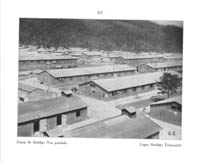 Grödig similar to the one used in College Associations. He organized prisoners into ten committees: welfare;
school; library and reading room; music; theater; cinematograph and gramophone; athletics and games; arts;
woodcarving and hand-work; and religion. The religion committee included one representative from each of the three
major faiths found in the camp: Roman Catholic, Russian Orthodox, and Jewish. With administration approval,
Ebersole assembled forty Russian students with educations in teaching, art, and music, and they selected the best
men to head these committees. The prisoners elected a former schoolteacher and natural leader as the general
secretary to assist Ebersole, and the Austrian officer appointed by the commandant as camp secretary demonstrated
a genuine interest in the welfare work. The three secretaries (Ebersole, the general secretary, and the camp
secretary) formed a "cabinet" with the ten committee leaders. This group met in the Association's barrack office
every Monday evening to plan out work for the upcoming week. This cabinet represented an interesting example of
democracy and self-help welfare at work.30
Grödig similar to the one used in College Associations. He organized prisoners into ten committees: welfare;
school; library and reading room; music; theater; cinematograph and gramophone; athletics and games; arts;
woodcarving and hand-work; and religion. The religion committee included one representative from each of the three
major faiths found in the camp: Roman Catholic, Russian Orthodox, and Jewish. With administration approval,
Ebersole assembled forty Russian students with educations in teaching, art, and music, and they selected the best
men to head these committees. The prisoners elected a former schoolteacher and natural leader as the general
secretary to assist Ebersole, and the Austrian officer appointed by the commandant as camp secretary demonstrated
a genuine interest in the welfare work. The three secretaries (Ebersole, the general secretary, and the camp
secretary) formed a "cabinet" with the ten committee leaders. This group met in the Association's barrack office
every Monday evening to plan out work for the upcoming week. This cabinet represented an interesting example of
democracy and self-help welfare at work.30
34
 The welfare committee visited the hospital barracks every Sunday afternoon and gave short musical performances,
either with the gramophone or the balalaika orchestra. The committee's primary goal was to determine which
prisoners were in the greatest need, and then improve their condition through personal counsel and cheer. Most
attention was focused on the invalids and sick POWs in the hospital. Committee members distributed shipments
of cocoa, chocolate, and biscuits systematically among the patients most in need, as designated by the prison
doctor.
The welfare committee visited the hospital barracks every Sunday afternoon and gave short musical performances,
either with the gramophone or the balalaika orchestra. The committee's primary goal was to determine which
prisoners were in the greatest need, and then improve their condition through personal counsel and cheer. Most
attention was focused on the invalids and sick POWs in the hospital. Committee members distributed shipments
of cocoa, chocolate, and biscuits systematically among the patients most in need, as designated by the prison
doctor.
 When the intended recipients of Zwieback shipped from Russia could not be found, the committee placed
these shipments at the disposal of the welfare committee. On Sunday afternoons, each patient received a piece
of milk chocolate in lieu of hot cocoa. Ebersole always accompanied this committee on its rounds when
he was in the camp. To entertain confined patients, the committee arranged weekly moving picture shows. The
music committee helped out the welfare committee in these efforts. The balalaika orchestra furnished music
for most events. Until winter weather set in, the committee gave shows every Wednesday evening for the lame,
halt, and blind. An important element of the welfare committee was the "petition bureau." Every evening, several
members of the committee met in the reading room of the Association hut to hear complaints or talk to prisoners
about their personal needs. Although specific desires could often not be readily met, many petitioners were
comforted simply by having their requests heard.
When the intended recipients of Zwieback shipped from Russia could not be found, the committee placed
these shipments at the disposal of the welfare committee. On Sunday afternoons, each patient received a piece
of milk chocolate in lieu of hot cocoa. Ebersole always accompanied this committee on its rounds when
he was in the camp. To entertain confined patients, the committee arranged weekly moving picture shows. The
music committee helped out the welfare committee in these efforts. The balalaika orchestra furnished music
for most events. Until winter weather set in, the committee gave shows every Wednesday evening for the lame,
halt, and blind. An important element of the welfare committee was the "petition bureau." Every evening, several
members of the committee met in the reading room of the Association hut to hear complaints or talk to prisoners
about their personal needs. Although specific desires could often not be readily met, many petitioners were
comforted simply by having their requests heard.
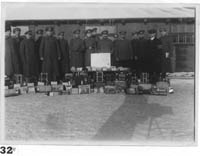 Urgent cases were immediately reported to the camp secretary and carried to the commandant for his assistance.
Committee members also distributed Russian relief packages in the prison camp, shipped via the YMCA office
in Copenhagen. Funding for the welfare committee came through the members of the camp Association. A total of
246 members paid ten Kronen each for the initial capital to pay for supplies. To raise additional revenue,
a part of the school barracks was remodeled to make a "Society and Tea Hall." Committee members purchased two
large heaters for hot water, and Ebersole used special funds received from Honolulu to purchase special glasses,
saucers, and spoons for the project. Hot tea was then sold at a price that even the poorest prisoner could afford
but that still covered costs. For the neediest POWs, the committee planned to distribute tickets for a free cup
of tea.31
Urgent cases were immediately reported to the camp secretary and carried to the commandant for his assistance.
Committee members also distributed Russian relief packages in the prison camp, shipped via the YMCA office
in Copenhagen. Funding for the welfare committee came through the members of the camp Association. A total of
246 members paid ten Kronen each for the initial capital to pay for supplies. To raise additional revenue,
a part of the school barracks was remodeled to make a "Society and Tea Hall." Committee members purchased two
large heaters for hot water, and Ebersole used special funds received from Honolulu to purchase special glasses,
saucers, and spoons for the project. Hot tea was then sold at a price that even the poorest prisoner could afford
but that still covered costs. For the neediest POWs, the committee planned to distribute tickets for a free cup
of tea.31
35
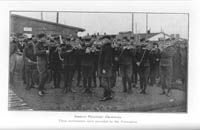 The other committees were equally ambitious. The library and reading room committee amassed a library of over
two thousand books, and established a bookbindery to keep the books in circulation. The school committee offered
classes ranging from basic alphabet courses to advanced Russian and arithmetic, algebra, geometry, bookbinding,
and German. The arts department obtained separate quarters for their classes for drawing and painting. Three
instructors taught a variety of art courses. The theater committee presented Russian and Ukrainian plays, as
well as a fortnightly moving picture show. To cover the costs of costumes and other expenses, the committee
charged a small admissions price for some of the seats. One of the most popular organizations was the music
committee. These members formed three music organizations: a Russian balalaika orchestra (fifteen pieces); a
Russian military band (twenty-nine pieces); and a choir of twenty-nine voices. Both the band and orchestra played
at theater and motion picture shows. The music committee also presented a short musical program of Russian and
Polish folk songs in the reading room every evening, which became very popular with the prisoners. The choir
took a leading part in the Russian Orthodox religious services on Sunday mornings and during the Christmas
holidays. All of the committees pooled their resources for the January 1917 Christmas festivities. Ebersole
obtained a large Christmas tree, which the POWs set up and decorated in the theater. The American YMCA collected
Christmas presents, including a package of tobacco from the commandant and sweets from the YMCA for each prisoner.
Ebersole found the Christmas celebrations the most rewarding part of his career because he was able to address
needy men in the true spirit of brotherhood. Both guards and prisoners could join together in a common cause,
forgetting their wartime animosities.32
The other committees were equally ambitious. The library and reading room committee amassed a library of over
two thousand books, and established a bookbindery to keep the books in circulation. The school committee offered
classes ranging from basic alphabet courses to advanced Russian and arithmetic, algebra, geometry, bookbinding,
and German. The arts department obtained separate quarters for their classes for drawing and painting. Three
instructors taught a variety of art courses. The theater committee presented Russian and Ukrainian plays, as
well as a fortnightly moving picture show. To cover the costs of costumes and other expenses, the committee
charged a small admissions price for some of the seats. One of the most popular organizations was the music
committee. These members formed three music organizations: a Russian balalaika orchestra (fifteen pieces); a
Russian military band (twenty-nine pieces); and a choir of twenty-nine voices. Both the band and orchestra played
at theater and motion picture shows. The music committee also presented a short musical program of Russian and
Polish folk songs in the reading room every evening, which became very popular with the prisoners. The choir
took a leading part in the Russian Orthodox religious services on Sunday mornings and during the Christmas
holidays. All of the committees pooled their resources for the January 1917 Christmas festivities. Ebersole
obtained a large Christmas tree, which the POWs set up and decorated in the theater. The American YMCA collected
Christmas presents, including a package of tobacco from the commandant and sweets from the YMCA for each prisoner.
Ebersole found the Christmas celebrations the most rewarding part of his career because he was able to address
needy men in the true spirit of brotherhood. Both guards and prisoners could join together in a common cause,
forgetting their wartime animosities.32
36
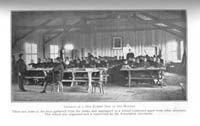 The American YMCA set up operations in four additional prison camps in Upper Austria and Lower Austria in
October 1916. Ebersole began POW services at Marchtrenk and Aschbach in Upper Austria in October 1916 maintained
the work in these camps until April 1917. During an initial inspection tour, MacNaughten and Ebersole found 160
Serbian cadets at Aschbach who had been students before the war. The commandant permitted Ebersole to begin a
special program for these cadets, and the Central Office in Vienna sent equipment and books to begin instruction
for the POWs under Serbian teachers. Since most of the cadets read several languages, the Association sent German,
French, and English books as well as Serbian literature to Aschbach. The "Y" also dispatched scientific texts for
engineering students. Classes for these students began in April 1917 and included instruction in German, French,
Italian, English, bookkeeping, and mechanical drawing. Activities were not limited simply to course work-the
students formed an orchestra and a glee club, and they arranged programs for vocal and instrumental music.
Ebersole encouraged these cadets to use this opportunity to work to improve themselves.33
The American YMCA set up operations in four additional prison camps in Upper Austria and Lower Austria in
October 1916. Ebersole began POW services at Marchtrenk and Aschbach in Upper Austria in October 1916 maintained
the work in these camps until April 1917. During an initial inspection tour, MacNaughten and Ebersole found 160
Serbian cadets at Aschbach who had been students before the war. The commandant permitted Ebersole to begin a
special program for these cadets, and the Central Office in Vienna sent equipment and books to begin instruction
for the POWs under Serbian teachers. Since most of the cadets read several languages, the Association sent German,
French, and English books as well as Serbian literature to Aschbach. The "Y" also dispatched scientific texts for
engineering students. Classes for these students began in April 1917 and included instruction in German, French,
Italian, English, bookkeeping, and mechanical drawing. Activities were not limited simply to course work-the
students formed an orchestra and a glee club, and they arranged programs for vocal and instrumental music.
Ebersole encouraged these cadets to use this opportunity to work to improve themselves.33
37
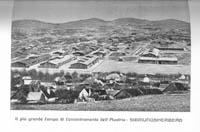 Roy Welker began Association work at Kleinmünchen in Upper Austria in January 1917 and supported the WPA
services in this camp until April 1917. Gustav Kaletsch inaugurated operations in Siegmundsherberg in Lower
Austria in March 1917 and supervised Red Triangle programs for through the following month. By March 1917, the International
Committee was prepared to send two new American secretaries to the Dual Monarchy, Henry J. Moeller and Richard
Siegfried Schwedler.34
Roy Welker began Association work at Kleinmünchen in Upper Austria in January 1917 and supported the WPA
services in this camp until April 1917. Gustav Kaletsch inaugurated operations in Siegmundsherberg in Lower
Austria in March 1917 and supervised Red Triangle programs for through the following month. By March 1917, the International
Committee was prepared to send two new American secretaries to the Dual Monarchy, Henry J. Moeller and Richard
Siegfried Schwedler.34
38 While American YMCA field secretaries developed War Prisoners' Aid programming in Austria-Hungary, the World's Alliance introduced and expanded relief services to Allied prisoners in Bulgaria. The impoverished conditions in this kingdom, as the result of three wars over a three-year period, made WPA operations a critical priority for Entente POWs languishing in Bulgarian prison camps.
Notes:
Note 1: "Austria," For the Millions of Men Now Under Arms 1 (31 July 1916): 38; International Committee Report, For the Millions of Men Now Under Arms 1 (31 January 1916): 43-45; Christian Phildius to John R. Mott, 20 September 1915, Geneva. John R. Mott Papers, Box 70, Folder 1279. Yale School of Divinity, New Haven, CT; William Howard Taft, Frederick Harris, Frederic Houston Kent, and William J. Newlin, eds., Service with Fighting Men: An Account of the Work of the American Young Men's Christian Association in the World War, 2 vols. (New York: Association Press, 1922), 2:306; Edgar MacNaughten, "Austria-Hungary: For Prisoners of War," For the Millions of Men Now Under Arms 2 (1 November 1916): 33; Baron von Spiegelfeld, "Central Powers," For the Millions of Men Now Under Arms 2 (1 February 1917): 39; Freiherr Markus von Spiegelfeld, Jahrsbericht des Auskunftstelle für Kriegsgefangene des gemeinsam zentralnachweise bureaus sowie des österreichischen Fürsorgekomitees für Kriegsgefangene für das Jahr 1916 (Vienna: Christoph Reisser's Söhne, circa 1917), 1-12. Box X391.1: "War Work YMCA, 1914-1918: In Austria Soldiers' Homes; in Switzerland: Commission Militaire Romande (Maisons du Soldats), Commission Romande des Internees; in Germany: Soldatenheim, Kriegsfürsorge." Section 436: "Austria." Folder: "War Prisoners' Aid in Austria: Records and Copies of Correspondence of Mr. Christian Phildius, 1914-1918." World's Alliance of YMCAs Archives, Geneva; and Edgar MacNaughten, "Committee of the Kriegsgefangenenhilfe Christlicher Vereine jünger Männer und Arbeitsausschuss beim Fürsorge-Kommitee des Ungarischen Roten Kreuz für Kriegsgefangene," circa 1916, 1. Box X391.1: "War Work YMCA, 1914-1918: In Austria: Soldiers' Homes; in Switzerland: Commission Militaire Romande (Maisons du Soldats), Commission Romande des Internees; in Germany: Soldatenheim, Kriegsfürsorge." Section 436: "Austria." Folder: "Austria: Reports and Exhibits: Work in Prison Camps." World's Alliance of YMCAs Archives, Geneva. back
Note 2: "Austria," 37-38; Edgar MacNaughten, "Austria-Hungary: For Prisoners of War," For the Millions of Men Now Under Arms 2 (1 November 1916): 34-35; "American Secretaries of Prisoner of War Aid and Other Work of the Young Men's Christian Associations," 16 March 1917. Box X391: "War Work Y.M.C.A., 1914-1918: World's Committee, Geneva." Folder: "War Prisoners' Aid Y.M.C.A.-Lists of Secretaries/Instructions for Secretaries, 1914-1918." World's Alliance of YMCAs Archives, Geneva; Jean Schoop, "Bericht von Jean Schoop über seine Arbeit im Dienst der 'Kriegsgefangenenhilfe,'" 20 March 1916, Vienna, 1-3. Box X391.2: "War Prisoners' Aid, YMCA, 1914-1918: P.O.W. Camps in Austria-Reports." Folder: "War Prisoners' Aid in Austria: Reports from P.O.W. Camps: Sopronnyek, Boldeegasszony, Zalägersezg, Ostiffiaszonyfa, Somorja, 1914-1918." World's Alliance of YMCAs Archives, Geneva; Max Wilhelmi to K.u.K. Kriegsministerium, 27 June 1917, Vienna, 11. Box X391.2: "War Prisoners' Aid, YMCA, 1914-1918: P.O.W. Camps in Austria-Reports." Folder: "War Prisoners' Aid in Austria, 1914-1918." World's Alliance of YMCAs Archives, Geneva; "American Secretaries in Prisoner of War Aid and Other Work of the Y.M.C.A.," 24 November 1916, 1. "American Secretaries of Prisoner of War Aid and Other War of the Young Men's Christian Associations," 16 March 1917, 12-13. Box X391: "War Work Y.M.C.A., 1914-1918: World's Committee, Geneva." Folder: "War Prisoners' Aid Y.M.C.A. -Lists of Secretaries/Instructions for Secretaries, 1914-1918." World's Alliance of YMCAs Archives, Geneva. back
Note 3: Edgar MacNaughten, "Austria-Hungary: For Prisoners of War," 34; Julius F. Hecker, "Wieselburg and Harth, Austria," For the Millions of Men Now Under Arms 2 (1 November 1916): 35; and Taft, Harris, Kent, and Newlin, Service with Fighting Men, 2:306-7. back
Note 4: Julius F. Hecker, "Wieselburg and Harth, Austria," 35; Amos A. Ebersole, "A Model College Association in Camp Groedig," For the Millions of Men Now Under Arms 2 (1 June 1917): 34; and Edgar F. MacNaughten, "In Hospitals and Among Boys," For the Millions of Men Now Under Arms 2 (1 June 1917): 30-31. back
Note 5: International Committee, Report of the International Committee of the YMCAs to the Fortieth International Convention at Detroit, Michigan, November 19-23, 1919 (New York: Association Press, 1919), 135-36; International Committee, "International Committee, Monthly Meeting Minutes, 1917-1924," 17 February 1917, New York. International Division, International Committee Box. American YMCA Archives, Minneapolis, MN; Archibald C. Harte to John R. Mott, 9/22 January 1917, Petrograd. Armed Services Records Box AS-21, War Work 1914-1918. American YMCA Archives, Minneapolis, MN; Conrad Hoffman to John R. Mott, December 1916, For the Millions of Men Now Under Arms 2 (1 July 1917): 46; and Archibald C. Harte, 2 April 1917, Stockholm. John R. Mott Papers, Box 38, Folder 701. Yale School of Divinity, New Haven, CT. back
Note 6: Edgar MacNaughten to Archibald C. Harte, 26 December 1916, 1-8. Box X391.2: "War Prisoners' Aid, YMCA, 1914-1918: P.O.W. Camps in Austria-Reports." Folder: "War Prisoners' Aid in Austria, 1914-1918." World's Alliance of YMCA Archives, Geneva; Raymond J. Reitzel, "A Social Community in Miniature," For the Millions of Men Now Under Arms 2 (1 February 1917): 42; Louis P. Penningroth, "A Father's Heart Cheered," For the Millions of Men Now Under Arms 2 (1 June 1917): 32; "Prisoners' Families Voice Gratitude," For the Millions of Men Now Under Arms 2 (1 June 1917): 37-38; "Money from Home," For the Millions of Men Now Under Arms 2 (1 June 1917): 38; and "Letters from Fathers and Sons," For the Millions of Men Now Under Arms 2 (1 June 1917): 39. back
Note 7: Christian Phildius, "Telegrams," For the Millions of Men Now Under Arms 1 (31 January 1916): 41; Christian Phildius, "Prisoners of War in Austria-Hungary," For the Millions of Men Now Under Arms 1 (31 January 1916): 41-42; Karl Fries and Christian Phildius, "Prisoners of War in Austria-Hungary," For the Millions of Men Now Under Arms 1 (15 April 1916): 34-35; and "Austria," 37-38. back
Note 8: "Opening of the Association at Braunau in Bohemia: The Prisoners at the Right Are Servians, Those at the Left Are Russians. Professor Wilz-Oberlin, the President of the Austrian National Alliance, Is Bareheaded in the Center. Mr. Christian Phildius, Secretary of the World's Committee, Is Standing in the Angle of the Walk," For the Millions of Men Now Under Arms, 1 (15 April 1916): 42A; and Clarence W. Bartz, "Russian Camps in Austria," For the Millions of Men Now Under Arms, 2 (1 June 1917): 40. back
Note 9: Christian Phildius, "Prisoners of War in Austria-Hungary," 41; Karl Fries and Christian Phildius, "Prisoners of War in Austria-Hungary," 34-35; Louis P. Penningroth, "At Braunau," For the Millions of Men Now Under Arms 1 (31 July 1916)" 42; Clarence W. Bartz, "At Braunau," For the Millions of Men Now Under Arms 2 (1 February 1917): 44; Clarence W. Bartz, "Russian Camps in Austria," For the Millions of Men Now Under Arms 2 (1 November 1917): 40; Louis P. Penningroth, "A Practical Life-Saver in a Prison Camp," Association Men 43 (September 1917): 17-18; C. W. Barth [sic], "Report for October 1916. Kriegsgefangenenlager Braunau i Böhmen," circa November 1916, 1-3. G. Bertz [sic], "Report of November and December 1916. Kriegsgefangenenlager Braunau in Böhmen," circa January 1917, 1. Amos A. Ebersole, "Weihnachtsbericht von Jahre 1916. Kriegsgefangenenlager Braunau a/Inn," circa December 1916, 1-4. C. W. Bartz, "A Review of Our Work in Braunau, Böhmen. October 1916-April 12, 1917," circa April 1917, 1-4. Box X391.2: "War Prisoners' Aid, YMCA, 1914-1918: P.O.W. Camps in Austria-Reports." Folder: "War Prisoners' Aid in Austria, Reports from P.O.W. Camps: Aschbach, Grödig, Braunau, 1914-1918." World's Alliance of YMCAs Archives, Geneva; and C. W. Bartz, "October Report of the Association Work in the Camp at Braunau i. B.," circa November 1916, 1-3. Box X391.2: "War Prisoners' Aid, YMCA, 1914-1918: P.O.W. Camps in Austria-Reports." Folder: "Austria: Reports and Exhibits: Work in Prison Camps." World's Alliance of YMCAs Archives, Geneva. back
Note 10: Louis P. Penningroth, "Young Boys in the Prison Camps," 41-42; Clarence W. Bartz, "At Braunau," For the Millions of Men Now Under Arms, 2 (1 February 1917): 44; and Edgar MacNaughten, "In Hospitals and Among Boys," For the Millions of Men Now Under Arms, 2 (1 June 1917): 31. back
Note 11: Louis P. Penningroth, "At Braunau,"42; Louis Philip Penningroth, "Young Boys in the Prison Camps," 43; "Austria-Hungary: For Prisoners of War," For the Millions of Men Now Under Arms 2 (1 February 1917): 40-41; Edgar F. MacNaughten, "In Hospitals and Among Boys," 31; "Citizens of a New Europe in the Making: These Are Some of the Boys Gathered from the Camps and Segregated in a School Compound Apart from Other Prisoners," For the Millions of Men Now Under Arms 2 (1 June 1917): 26C; "2,000 Servian Boys at Braunau, Austria, Are Receiving Special Food and Care through the Association," For the Millions of Men Now Under Arms 2 (1 November 1917): 40A; Louis P. Penningroth, "A Practical Life-Saver in a Prison Camp," 18; C. W. Barth [sic], "Report for October 1916. Kriegsgefangenenlager Braunau in Böhmen," circa January 1917, 1. G. Bertz [sic], "Report of November and December 1916. Kriegsgefangenenlager Braunau in Böhmen, circa January 1917. Clarence W. Bartz, "At Braunau," 44; Clarence W. Bartz, "Russian and Servian Boys in Austria," For the Millions of Men Now Under Arms, 2 (1 ovember 1917): 43; Clarence W. Bartz, "Russian Camps in Austria," 40; C. W. Bartz, "A Review of Our Work in Braunau, Böhmen. October 1916-April 12, 1917," circa April 1917, 1-4. Box X391.2: "War Prisoners' Aid, Y.M.C.A., 1914-1918: P.O.W. Camps in Austria-Reports." Folder: "War Prisoners' Aid in Austria, Reports from P.O.W. Camps: Aschbach, Grödig, Braunau, 1914-1918." World's Alliance of YMCAs Archives, Geneva. back
Note 12: Christian Phildius, "Prisoners of War in Austria-Hungary," 42; "Austria," 37; "Association Hall at Sopronnyek, a Russian Prisoner-of-War Camp in Hungary," For the Millions of Men Now Under Arms 1 (31 July 1916): 24D; Jean Schoop, "War Prisoners' Camp at Boldogasszony (Hungary)," For the Millions of Men Now Under Arms 2 (1 November 1916): 38; Jean Schoop, "Report for September 1916. Kriegsgefangenenlager Sopronnyek, Hungary," circa October 1916, 1. Box X391.2: "War Prisoners' Aid, YMCA, 1914-1918: P.O.W. Camps in Austria-Reports." Folder: "Austria: Reports and Exhibits: Work in Prison Camps." World's Alliance of YMCAs Archives, Geneva; and Jean Scoop, "Report for October 1916. Kriegsgefangenenlager Sopronnyek, Hungary," circa November 1916, 1. Box X391.2: "War Prisoners' Aid, YMCA, 1914-1918: P.O.W. Camps in Austria-Reports." Folder: "War Prisoners' Aid in Austria: Reports from P.O.W. Camps: Sopronnyek, Boldogasszony, Zalägersezg, Ostiffiaszonyfra, Somorja, 1914-1918." World's Alliance of YMCAs Archives, Geneva. back
Note 13: "The Association Hall in the Camp at Spratzern," For the Millions of Men Now Under Arms 1 (31 July 1916): 40B; "Prisoner-of-War Camp at Spratzern, Austria: The Russian Prisoners Quartered Here Number 37,000," For the Millions of Men Now Under Arms 1 (31 July 1916): 40B; Theodore Schroeder, "Spratzern," For the Millions of Men Now Under Arms 2 (1 November 1917): 38; and Gustav J. Kalestsch, "Report for the Months of March and April 1917. War Prisoners Camp Spratzern," circa May 1917, 1. Box X391.2: "War Prisoners' Aid, YMCA, 1914-1918: P.O.W. Camps in Austria-Reports." Folder: "War Prisoners' Aid in Austria: Reports from P.O.W. Camps: Milowitz, Spratzern, Seigmundsherberg, Nagymegyer, Dunaszerdahely, Kenzermezö, Kleinmünchen, 1914-1918." World's Alliance of YMCAs Archives, Geneva. back
Note 14: Julius F. Hecker, "For Prisoners of War: Wieselburg-Camp of 57,000," For the Millions of Men Now Under Arms 1 (31 July 1916): 38; and "Prisoners Cheered at an Entertainment," For the Millions of Men Now Under Arms 2 (1 February 1917): 26F. back
Note 15: Julius F. Hecker, "For Prisoners of War: Wieselburg-Camp of 57,000," 40-41; "Opening Association Building (Second from Left) at Wieselburg: Among These Prisoners Are Some Five Thousand Permanently Crippled," For the Millions of Men Now Under Arms 2 (1 February 1917): 26G; and Julius F. Hecker, "Wieselburg and Harth, Austria," For the Millions of Men Now Under Arms 2 (1 November 1916): 35. back
Note 16: Julius F. Hecker, "Wieselburg and Harth, Austria," 35; "One of the Class Rooms at Wieselburg," For the Millions of Men Now Under Arms 2 (1 February 1917): 26G; and Edgar MacNaughten, "In Hospitals and Among Boys," 31. back
Note 17: Julius F. Hecker, "Wieselburg and Harth, Austria," 37; "Opening of the Association Building at Harth: The Insets Above and on the Opposite Page Show a Few of the Thousand and More Boys Recently Segregated from the Men's Camp and Organized for Educational Work," For the Millions of Men Now Under Arms 2 (1 February 1917): 26F; Louis P. Penningroth, "A Practical Life-Saver in a Prison Camp," 18; and Julius F. Hecker, "Bericht über die Monate November, Dezember bis 15 Januar 1917. Distrikt Wieselberg-Hart-Purgstall," circa January 1917, 16. Box X391.2: "War Prisoners' Aid, YMCA, 1914-1918: P.O.W. Camps in Austria-Reports." Folder: Various Camps. World's Alliance of YMCAs Archives, Geneva. back
Note 18: Theodore Schroeder, "Extracts from Secretaries' Letters," For the Millions of Men Now Under Arms 1 (31 July 1916): 41. back
Note 19: Amos A. Ebersole, "Weihnachtsbericht von Jahre 1916. Kriegsgefangenenlager Braunau a/Inn," circa December 1916, 1-4. Box X391.2: "War Prisoners' Aid, Y.M.C.A., 1914-1918: P.O.W. Camps in Austria-Reports." Folder: "War Prisoners' Aid in Austria, Reports from P.O.W. Camps: Aschbach, Groedig, Braunau, 1914-1918." World's Alliance of YMCAs Archives, Geneva. back
Note 20: "Austria," 37-38; Edgar MacNaughten, "Austria-Hungary: For Prisoners of War," 33; "With Italian Prisoners in Austria," in With Italians in Captivity (Lugano: Arti Gafiche Veladini and Company, n.d.), 1-12. Box X391.2: "War Prisoners' Aid, YMCA, 1914-1918: P.O.W. Camps in Austria-Reports." Folder: "War Prisoners' Aid in Austria: Reports from P.O.W. Camps: Josephstadt, Eger, Heinrichsgrün, Mauthausen, 1914-1918." World's Alliance of YMCAs Archives, Geneva; Eberhard Phildius, "The Camp at Mauthausen for Italian Prisoners of War: Secretary, Eberhard Phildius. Report for the Period from 23rd May to 17th July 1916," circa July 1916, 1-4. Eberhard Phildius, "Camp de Mauthausen. Rapport du 15 Juillet a fin Aout 1916," circa September 1916, 1-2. Roy A. Welker, "Report of War Prisoners' Aid, January 9-March 9, 1917, War Prisoners Camp of Mauthausen, Austria," circa March 1917, 1-3. Box X391.2: "War Prisoners' Aid, YMCA, 1914-1918: P.O.W. Camps in Austria-Reports." Folder: "War Prisoners' Aid in Austria: Reports from P.O.W. Camps: Josephstadt, Eger, Heinrichsgrün, Mauthausen, 1914-1918." World's Alliance of YMCAs Archives, Geneva; Roy A. Welker, "Suggested Plan of Supplying Books to Italian Prisoners of War in Austria-Hungary," no date, 1-2. Box X391.2: "War Prisoners' Aid, YMCA, 1914-1918: P.O.W. Camps in Austria-Reports." Folder: "War Prisoners' Aid in Austria, 1914-1918." World's Alliance of YMCAs Archives, Geneva; and Taft, Harris, Kent, and Newlin, Service with Fighting Men, 2:312. back
Note 21: Edgar MacNaughten, "Austria-Hungary: For Prisoners of War," 35; Raymond J. Reitzel, "A Social Community in Miniature," 41; Raymond J. Reitzel, "Secretaries in the Making," For the Millions of Men Now Under Arms 2 (1 November 1917): 44; Raymond J. Reitzel, "Report for September and October 1916. Kriegsgefangenenlager Zalägerszeg, Hungary," circa November 1916, 1. Box X391.2: "War Prisoners' Aid, YMCA, 1914-1918: P.O.W. Camps in Austria-Reports." Folder: "Austria: Reports and Exhibits: Work in Prison Camps." World's Alliance of YMCAs Archives, Geneva; and Raymond J. Reitzel, "Report: Prisoners of War Camps Zalägerszeg Ostfiaszonyfra, Somorja, January, February, and March 1917," April 10, 1917, Vienna, 1-5. Box X391.2: "War Prisoners' Aid, YMCA, 1914-1918: P.O.W. Camps in Austria-Reports." Folder: "War Prisoners' Aid in Austria: Reports from P.O.W. Camps: Sopronnyek, Boldogasszony, Zalägersezg, Ostiffiaszonyfa, Somorja, 1914-1918." World's Alliance of YMCAs Archives, Geneva. back
Note 22: Edgar MacNaughten, "Austria-Hungary: For Prisoners of War," 34; and Raymond J. Reitzel, "A Social Community in Miniature," 41-42. back
Note 23: Raymond J. Reitzel, "A Social Community in Miniature," 42; Raymond J. Reitzel, "Secretaries in the Making," 44; and Raymond J. Reitzel, "A Token of Appreciation," For the Millions of Men Now Under Arms 2 (1 November 1917): 44. back
Note 24: Edgar MacNaughten, "Austria-Hungary: For Prisoners of War," 34; Jean Schoop, "War Prisoners' Camp at Boldogasszony (Hungary)," For the Millions of Men Now Under Arms 2 (1 November 1916): 37-38; Heinrich A. Münger, "Report for October 1916. Kriegsgefangenlager Nagymegyer, Hungary," circa November 1916, 1. Box X391.2: "War Prisoners' Aid, YMCA, 1914-1918: P.O.W. Camps in Austria-Reports." Folder: "Austria: Reports and Exhibits: Work in Prison Camps." World's Alliance of YMCAs Archives, Geneva; Heinrich A. Münger, "Christmas Report 1917. War Prisoners Camp Nagymegyer," circa January 1918, 1. Heinrich A. Münger, "Report on the War Prisoners' Aid, War Prisoners Camp Dunaszerdahely," 6 March 1917, 1. Heinrich A. Münger, "Report of Christmas 1917, War Prisoners Camp Dunaszerdahely," 12 January 1918, 1-2. Box X391.2: "War Prisoners' Aid, YMCA, 1914-1918: P.O.W. Camps in Austria-Reports." Folder: "War Prisoners' Aid in Austria: Reports from P.O.W. Camps: Milowitz, Spratzern, Siegmundsherberg, Nagymegyer, Dunaszerdahely, Kenzermezo, Kleinmuenchen, 1914-1918." World's Alliance of YMCAs Archives, Geneva; Jean Schoop, "Bericht über die Tätigkeit der "Kriegsgefangenenhilfe" im K.u.K. Kriegsgefangenenlager zu Boldogasszony (Ungarn)," 27 May 1916, Vienna, 1-3. Box X391.2: "War Prisoners' Aid, YMCA, 1914-1918: P.O.W. Camps in Austria-Reports." Folder: "War Prisoners' Aid in Austria: Reports from P.O.W. Camps: Sopronnyek, Boldogasszony, Zalägersezg, Ostiffiaszonyfra, Somorja, 1914-1918." World's Alliance of YMCAs Archives, Geneva; Jean Schoop, "Report for September 1916, Kriegsgefangenenlager, Boldogasszony, Hungary," circa October 1916, 1. Box X391.2: "War Prisoners' Aid, YMCA, 1914-1918: P.O.W. Camps in Austria-Reports." Folder: "Austria: Reports and Exhibits: Work in Prison Camps." World's Alliance of YMCAs Archives, Geneva; Raymond J. Reitzel, "Report for October 1916, Kriegsgefangenenlager Ostfiassyzoyfra, Ungarn," circa November 1916, 1. Box X391.2: "War Prisoners' Aid, YMCA, 1914-1918: P.O.W. Camps in Austria-Reports." Folder: "Austria: Reports and Exhibits: Work in Prison Camps." World's Alliance of YMCAs Archives, Geneva; Raymond J. Reitzel, "Bericht für Dezember 1916. Kriegsgefangenenlager Somorja, Ungarn," circa January 1917, 1. Raymond J. Reitzel, "Report of October 1916. Camp of Ostffiaszonyfra, Hungary," circa November 1916, 1. Box X391.2: "War Prisoners' Aid, YMCA, 1914-1918: P.O.W. Camps in Austria-Reports." Folder: "War Prisoners' Aid in Austria: Reports from P.O.W. Camps: Sopronnyek, Boldogasszony, Zalägersezg, Ostiffiaszonyfra, Somorja, 1914-1918." World's Alliance of YMCAs Archives, Geneva. back
Note 25: Edgar MacNaughten, "Austria-Hungary: For Prisoners of War," 33; Anthony W. Chez, "At Kenyermezö," For the Millions of Men Now Under Arms 2 (1 February 1917): 43-44; Anthony W. Chez, "Kenyermezö (Hungary)," For the Millions of Men Now Under Arms, 2 (1 June 1917), 38; Anthony W. Chez, "Report for October 1916. Kriegsgefangenlager Kenyermezö, Hungary," 1-3. Box X391.2: "War Prisoners' Aid, YMCA, 1914-1918: P.O.W. Camps in Austria-Reports." Folder: "War Prisoners' Aid in Austria: Reports from P.O.W. Camps: Milowitz, Spratzern, Siegmundsherberg, Nagymegyer, Dunaszerdahely, Kenzermezö, Kleinmünchen, 1914-1918." World's Alliance of YMCAs Archives, Geneva; and Anthony W. Chez, "War Prisoners Camp Kenyermezö: Report for September 1916," circa October 1916, 1-2. Box X391.2: "War Prisoners' Aid, YMCA, 1914-1918: P.O.W. Camps in Austria-Reports." Folder: "Austria: Reports and Exhibits: Work in Prison Camps." World's Alliance of YMCAs Archives, Geneva. back
Note 26: MacPherson H. Donaldson, "Work Among Illiterate Russian Prisoners," For the Millions of Men Now Under Arms, 2 (1 February 1917): 42. back
Note 27: Edgar MacNaughten, "Austria-Hungary: For Prisoners of War," 33; MacPherson H. Donaldson, "Work Among Illiterate Russian Prisoners," For the Millions of Men Now Under Arms 2 (1 February 1917): 42-43; "Serbian Prisoners' Orchestra: These Instruments Were Provided by the Association," For the Millions of Men Now Under Arms 2 (1 June 1917): 42B; MacPherson H. Donaldson, "Bericht 11 November bis 15 Dezember 1916. Kriegsgefangenlager Heinrichsgrün," 15 December 1916, 1. MacPherson H. Donaldson, "Report on Eger and Heinrichsgrün on My Leaving, April 14th, 1917," 1. Box X391.2: "War Prisoners' Aid, YMCA, 1914-1918: P.O.W. Camps in Austria-Reports." Folder: "War Prisoners' Aid in Austria: Reports from P.O.W. Camps: Josephstadt, Eger, Heinrichsgruen, Mauthausen, 1914-1918." World's Alliance of YMCAs Archives, Geneva; and MacPherson H. Donaldson, "Report for September 1916, Kriegsgefangenenlager Eger in Boehmen," circa October 1916, 1-2. Box X391.2: "War Prisoners' Aid, YMCA, 1914-1918: P.O.W. Camps in Austria-Reports." Folder: "Austria: Reports and Exhibits: Work in Prison Camps." World's Alliance of YMCAs Archives, Geneva. back
Note 28: MacPherson H. Donaldson, "Work Among Illiterate Russian Prisoners," 42-43. back
Note 29: C. W. Bartz, "Report of the Christmas Festivities at the Prison Camp Josephstadt," 15 January 1917, 1. C. W. Bartz, "Report for January and February 1917. War Prisoners Camp Josephstadt, Bohemia," circa February 1917. 1-2. Torsten Wallenius, "Report for Months of January-May 1918. War Prisoners Camp Josephstadt," circa June 1917, 1. Box X391.2: "War Prisoners' Aid, YMCA, 1914-1918: P.O.W. Camps in Austria-Reports." Folder: "War Prisoners' Aid in Austria: Reports from P.O.W. Camps: Josephstadt, Eger, Heinrichsgrün, Mauthausen, 1914-1918." World's Alliance of YMCAs Archives, Geneva; W. E. Lauterbach, "Bericht der Kriegsgefangenenhilfe C.V.J.M. 26 November-8 Januar 1917. Kriegsgefangenenlager Deutsch-Gabel, Boehmen," circa January 1917, 1-2. Box X391.2: "War Prisoners' Aid, YMCA, 1914-1918: P.O.W. Camps in Austria-Reports." Folder: "War Prisoners' Aid in Austria: Reports from P.O.W. Camps: Reichenberg, Deutsch-Gabel, Theresienstadt, 1914-1918." World's Alliance of YMCAs Archives, Geneva; W. E. Lauterbach, "Report for the Last Half of October 1916. Kriegsgefangenenlager Theresienstadt, in Boehmen," circa November 1916, 1. W. E. Lauterbach, "Report for January and February 1917. War Prisoners Camp, Theresienstadt, Boehmen," circa March 1917, 1-2. Box X391.2: "War Prisoners' Aid, YMCA, 1914-1918: P.O.W. Camps in Austria-Reports." Folder: "War Prisoners' Aid in Austria: Reports from P.O.W. Camps: Reichenberg, Deutsch-Gabel, Theresienstadt, 1914-1918." World's Alliance of YMCAs Archives, Geneva; Clarence W. Bartz, "Report of the Christmas Festivities at the Prison Camp Milowitz," 15 January 1917, 1. Anthony W. Chez, "Extracts from Secretary Chez's Letter Concerning Milowitz and Brüx, February and March 1917," circa April 1917, 1. Box X391.2: "War Prisoners' Aid, YMCA, 1914-1918: P.O.W. Camps in Austria-Reports." Folder: "War Prisoners' Aid in Austria: Reports from P.O.W. Camps: Milowitz, Spratzern, Siegmundsherberg, Nagymegyer, Dunaszerdahely, Kenzermezö, Kleinmünchen, 1914-1918." World's Alliance of YMCAs Archives, Geneva; Hermann Morgenthaler, "A Report on the Christmas Celebrations in the War Prisoners Camp of Plan, Bohemia," January 1918, Plan, Austria, 1-2. Box X391.2: "War Prisoners' Aid, YMCA, 1914-1918: P.O.W. Camps in Austria-Reports." Folder: Various Camps. World's Alliance of YMCAs Archives, Geneva; and Anthony W. Chez, "Extracts from Secretary Chez's Letter Concerning Milowitz and Brüx, February and March 1917," circa April 1917, 1. Box X391.2: "War Prisoners' Aid, YMCA, 1914-1918: P.O.W. Camps in Austria-Reports." Folder: "War Prisoners' Aid in Austria: Reports from P.O.W. Camps: Milowitz, Spratzern, Siegmundsherberg, Nagymegyer, Dunaszerdahely, Kenzermezö, Kleinmünchen, 1914-1918." World's Alliance of YMCAs Archives, Geneva. back
Note 30: W. E. Lauterbach, "Report of January and February 1917. War Prisoners Camps Reichenberg, Deutsch-Gabel, Theresienstadt," circa March 1917, 1-7. W. E. Lauterbach, "Report for March and April 1917. War Prisoners Camps: Reichenberg, Deutsch-Gabel, Theresienstadt," circa May 1917, 1-7. W. E. Lauterbach, "Report of the Work, Camp of Reichenberg, Bohemia. Month of December 1916," 8 January 1917, Reichenberg, Austria, 1-2. Box X391.2: "War Prisoners' Aid, YMCA, 1914-1918: P.O.W. Camps in Austria-Reports." Folder: "War Prisoners' Aid in Austria: Reports from P.O.W. Camps: Reichenberg, Deutsch-Gabel, Theresienstadt, 1914-1918." World's Alliance of YMCAs Archives, Geneva; Amos A. Ebersole, "A Model College Association in Camp Grödig," For the Millions of Men Now Under Arms 2 (1 June 1917): 32-33; Amos A. Ebersole, "Report of October 1916. Kriegsgefangenlager Grödig near Salzburg," circa November 1916, 1-3. Box X391.2: "War Prisoners' Aid, YMCA, 1914-1918: P.O.W. Camps in Austria-Reports." Folder: "Austria: Reports and Exhibits: Work in Prison Camps." World's Alliance of YMCAs Archives, Geneva; and Amos A. Ebersole, "Report of Activities: Kriegsgefangenlager Grödig near Salzburg for Three Months Ending January 1917," circa February 1917, 1-4. Box X391.2: "War Prisoners' Aid, YMCA, 1914-1918: P.O.W. Camps in Austria-Reports." Folder: "War Prisoners' Aid in Austria, Reports from P.O.W. Camps: Aschbach, Grödig, Braunau, 1914-1918." World's Alliance of YMCAs Archives, Geneva. back
Note 31: Edgar MacNaughten, "In Hospitals and Among Boys," 30; and Amos A. Ebersole, "A Model College Association in Camp Grödig," For the Millions of Men Now Under Arms 2 (1 June 1917): 32-34. back
Note 32: Amos A. Ebersole, "A Model College Association in Camp Grödig," 34-37. back
Note 33: Amos A. Ebersole, "Austria-Hungary: For Prisoners of War: An Unusual Group," For the Millions of Men Now Under Arms 2 (1 November 1917): 42-43; and Amos A. Ebersole, "Report up to February 1st, 1917. Prisoner of War Camp Aschbach," circa February 1917, 1-2. Amos A. Ebersole, "The Opening of Our First Barrack in Kriegsgefangenenlager Aschbach," 12 April 1917, 1-2. Amos A. Ebersole, "Report for January, February, and March 1917. Prisoner of War Camp Grödig, Braunau a/Inn, Aschbach, and Marchtrenk," circa April 1917, 1-6. Box X391.2: "War Prisoners' Aid, YMCA, 1914-1918: P.O.W. Camps in Austria-Reports." Folder: "War Prisoners' Aid in Austria, Reports from P.O.W. Camps: Aschbach, Grödig, Braunau, 1914-1918." World's Alliance of YMCAs Archives, Geneva. back
Note 34: Gustav J. Kalestsch, "A Report of the Work of the Assistance Rendered to the Prisoners of War at the Camp of Siegmundsherberg, Austria," no date, 1-2. Gustav J. Kalestsch, "Report for the Months of March and April 1917. War Prisoners Camp Siegmundsherberg," 14 April 1917, 1. Box X391.2: "War Prisoners' Aid, YMCA, 1914-1918: P.O.W. Camps in Austria-Reports." Folder: "War Prisoners' Aid in Austria: Reports from P.O.W. Camps: Milowitz, Spratzern, Siegmundsherberg, Nagymegyer, Dunaszerdahely, Kenzermezö, Kleinmünchen, 1914-1918." World's Alliance of YMCAs Archives, Geneva; and Roy A. Welker, "Report for the Month of March and Up to April 12, 1917. War Prisoners Camp Kleinmünchen (Ober-österreich)," 12 April 1917, 1-2. Box X391.2: "War Prisoners' Aid, YMCA, 1914-1918: P.O.W. Camps in Austria-Reports." Folder: "War Prisoners' Aid in Austria: Reports from P.O.W. Camps: Milowitz, Spratzern, Siegmundsherberg, Nagymegyer, Dunaszerdahely, Kenzermezö, Kleinmünchen, 1914-1918." World's Alliance of YMCAs Archives, Geneva. back


